
On the cover The eye of a cuttlefish. The chromatophores, the sense organs that allow the animal to quickly change color and camouflage itself, are in frantic activity to try to distract the photographer, which, in this case, is detected as a predator.
FROM - 68 TO - 131 FEET (first session)
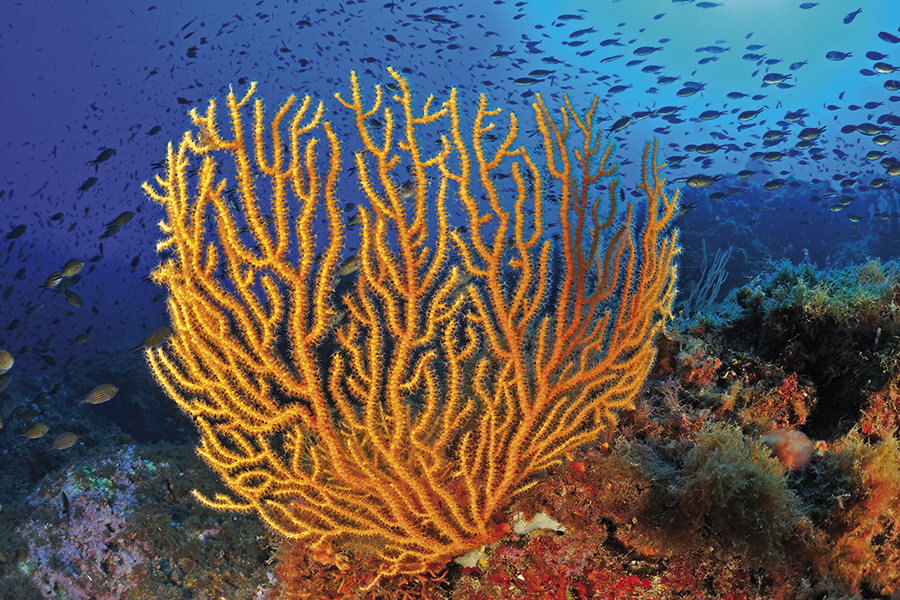 Going down, walls are covered with sea fans, They are the signal we are deep. Sea fans are awesome in Mediterranean too. The white Eunicella cavolini, the yellow Cavolinii, (photo above, Conca dei Marini - Salerno), the red Paramuricea clavata, mark the various stages of depth. In Italian language the origin of the name, might be recalling the mythological gorgons, three sisters, we do not know if monstrous or beautiful, which perhaps wanted to symbolize the vices of mortals, sources of enjoyment and set of perdition. Sea fans are very strong organisms and they feed on plankton. Summertime, because of the progressive warming of the waters they are always covered with mucilage. It was thought that this could cause death, but the facts shown that such filamentous algae doesn’t stifle sea fans polyp colonies, but only the ambitions of photographer, who will have to wait for the next storm to shot great fans in all the their glory.
Going down, walls are covered with sea fans, They are the signal we are deep. Sea fans are awesome in Mediterranean too. The white Eunicella cavolini, the yellow Cavolinii, (photo above, Conca dei Marini - Salerno), the red Paramuricea clavata, mark the various stages of depth. In Italian language the origin of the name, might be recalling the mythological gorgons, three sisters, we do not know if monstrous or beautiful, which perhaps wanted to symbolize the vices of mortals, sources of enjoyment and set of perdition. Sea fans are very strong organisms and they feed on plankton. Summertime, because of the progressive warming of the waters they are always covered with mucilage. It was thought that this could cause death, but the facts shown that such filamentous algae doesn’t stifle sea fans polyp colonies, but only the ambitions of photographer, who will have to wait for the next storm to shot great fans in all the their glory.
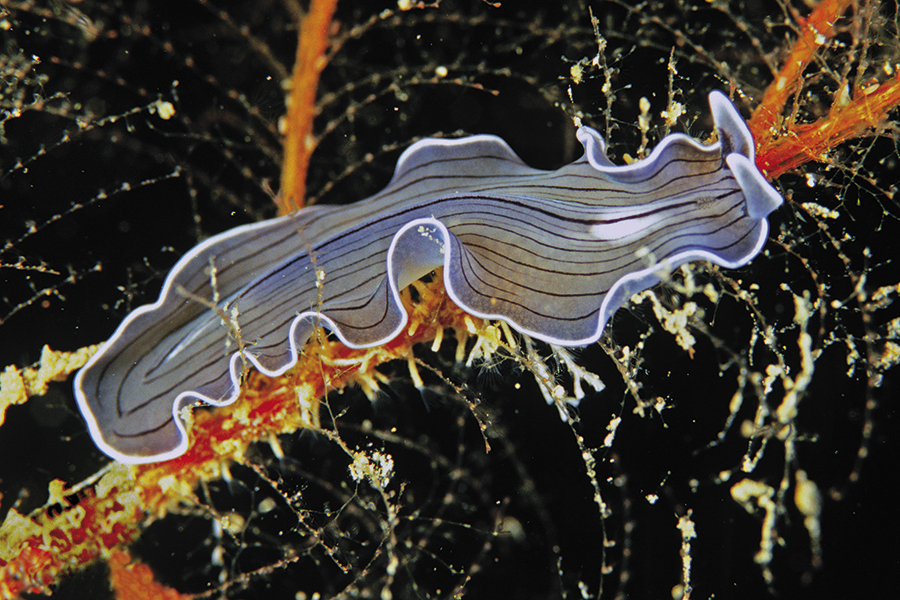 A flat plate worm (Prostheceraeus vittatus) looking for food on a dead branch of a yellow sea fan covered with hydrozoans (Halocordyle disticha).
A flat plate worm (Prostheceraeus vittatus) looking for food on a dead branch of a yellow sea fan covered with hydrozoans (Halocordyle disticha).
(Praiano - Salerno)
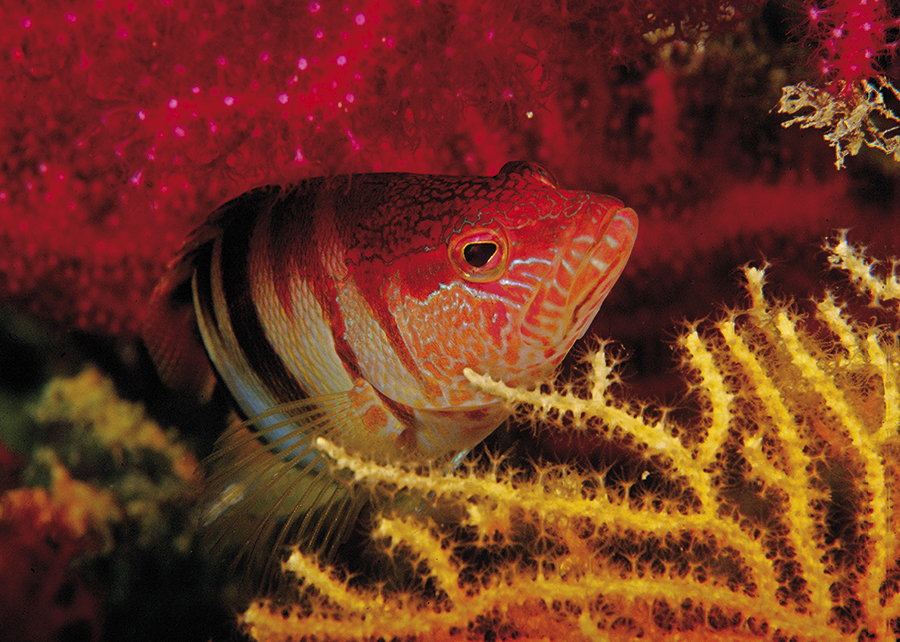 A superb specimen of Serranus scriba framed among both yellow and red sea fans.
A superb specimen of Serranus scriba framed among both yellow and red sea fans.
(Elba island - Livorno)
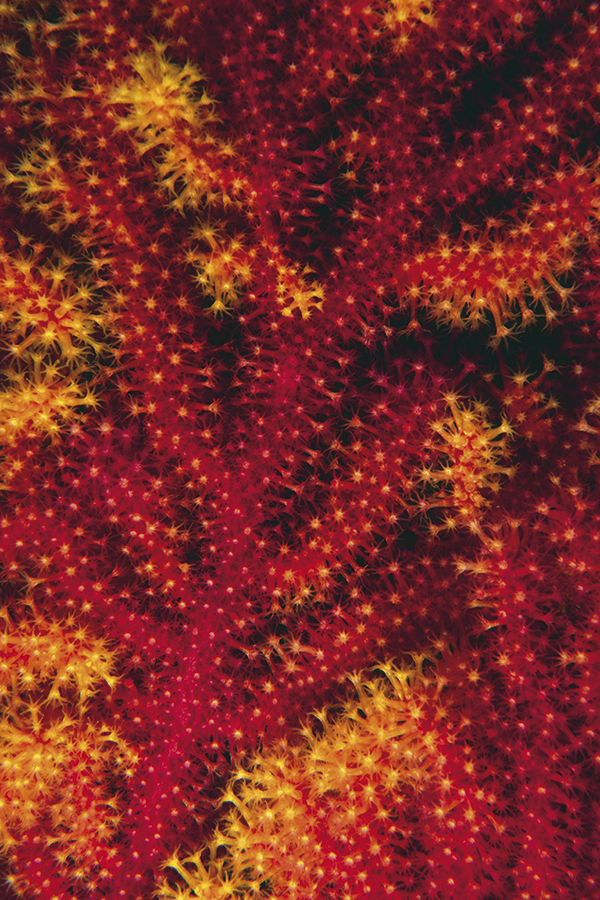
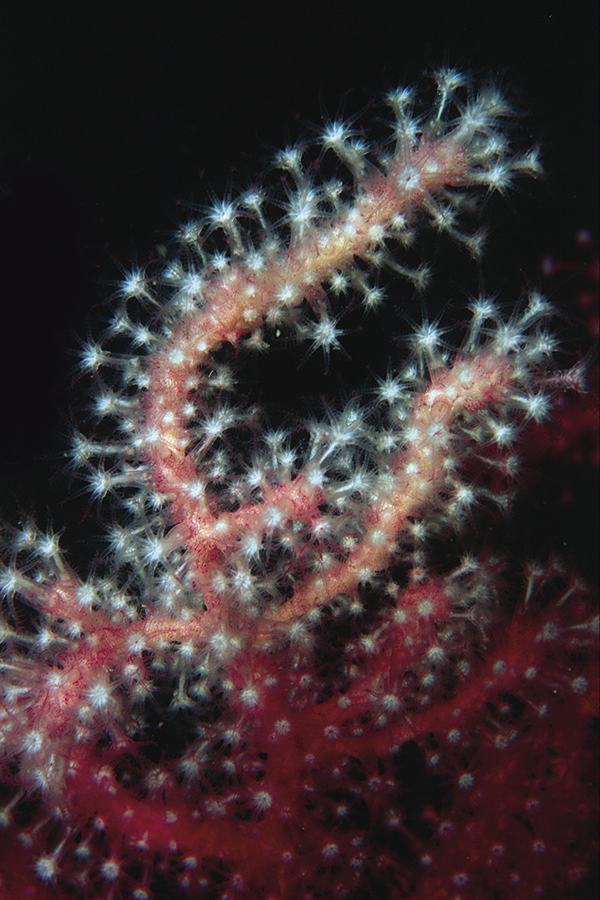
Biological varieties of Paramuricea clavata are really interesting.
Some very rare branches (photo right) are characterized by white tips.
The old scientific name of Paramuricee chamaleon, comes perhaps from the two colors, yellow and red, of great sea fans reported in abundant communities only in some place, as Tremiti islands, Scilla and the Medas islands in Spain.
(Scilla - Reggio Calabria)
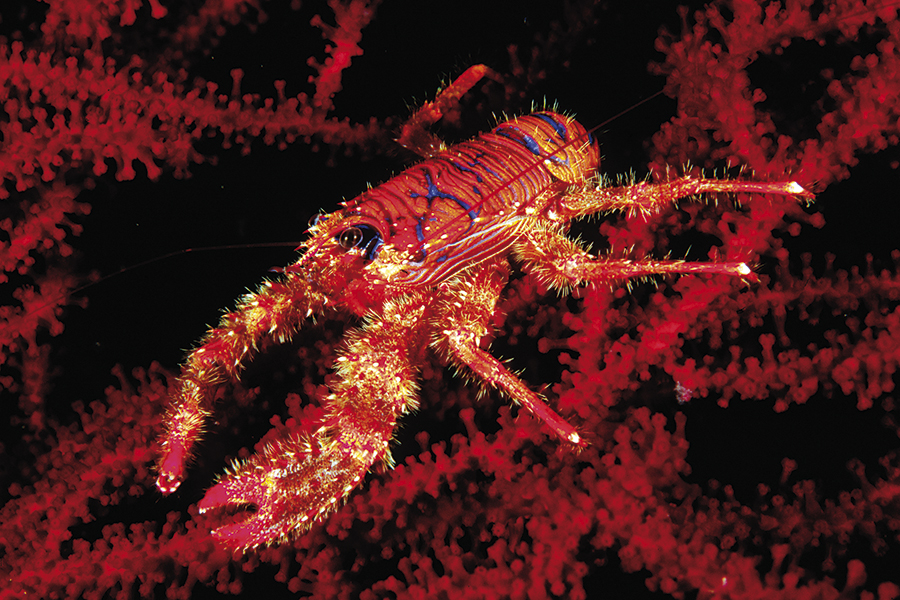 The galatea (Galathea strigosa) is a particular and unmistakable crustacean, because of the large menacing claws, in layers carapace and the hairy body.
The galatea (Galathea strigosa) is a particular and unmistakable crustacean, because of the large menacing claws, in layers carapace and the hairy body.
In Greek mythology, where often one goes when thinking of the names of sea creatures, it was a nymph, inhabitant of the depths, the Cyclops Polyphemus fell in love with, because of her beauty. Situation portrayed is absolutely not frequent: it’s an inhabitant of caves and dark environments, and it went for a walk, on a red sea fan grown in a dark and awesome tunnel, in a stretch of sea anything but miserly with wonders, in spite of the strong pollution of the town and of the proximity to one of the most terrible rivers in Italy, a circumstance that makes us thinking about relativity of many biological beliefs and power of sea to overcome obstacles to hinder its survival.
(Castellammare di Stabia - Naples)
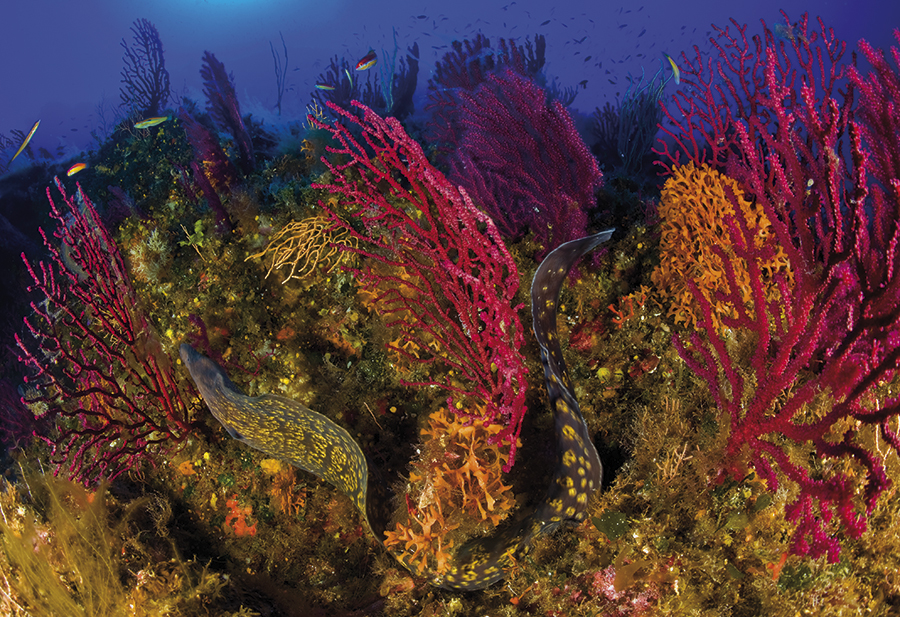 Meeting a moray eel out of the den is not common, quite strange finding it hunting along the walls covered by corals. It seemed, on the time, a predator hiding in the middle of the “plants”, but it literally sketched away at the approach of a far more formidable predator, although, at the time, he was equipped just with a camera.
Meeting a moray eel out of the den is not common, quite strange finding it hunting along the walls covered by corals. It seemed, on the time, a predator hiding in the middle of the “plants”, but it literally sketched away at the approach of a far more formidable predator, although, at the time, he was equipped just with a camera.
(Stromboli - Messina)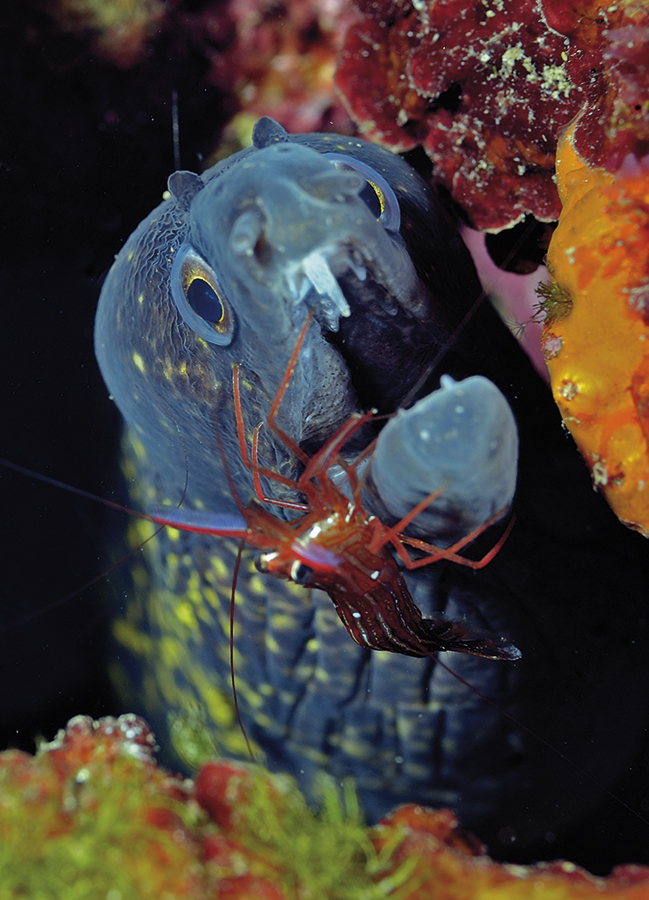
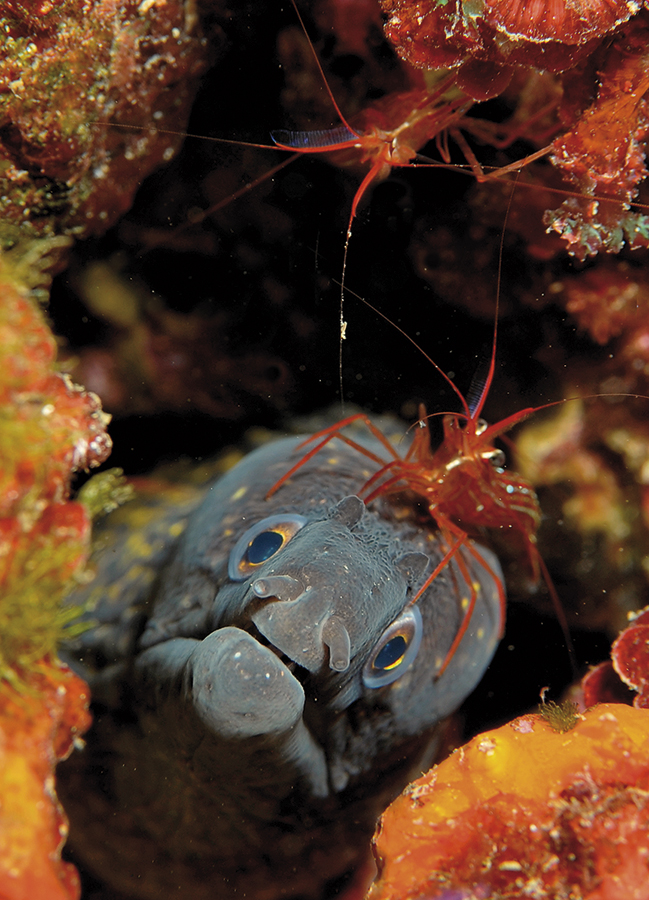
Perhaps the similarity between many biologic sides of the Mediterranean sea and the tropical ones is proved, along with the one of the shrimp living among crinoids arms, by symbiosis between the moray eel (Muraena helena) and the cleaner shrimp. It is a relatively recent discovery, thanks to underwater photographers. In Mediterranean sea Lysmata seticaudata is the crustacean which, due to the subtlety of the claws, performs the typical functions of the “cleaning stations”. The shrimp feeds on the little food’s left between the teeth of the predator which, in turn, it looks good from doing, as it could, a single bite of the visitor.
(Scoglio del Vervece - Sorrento)
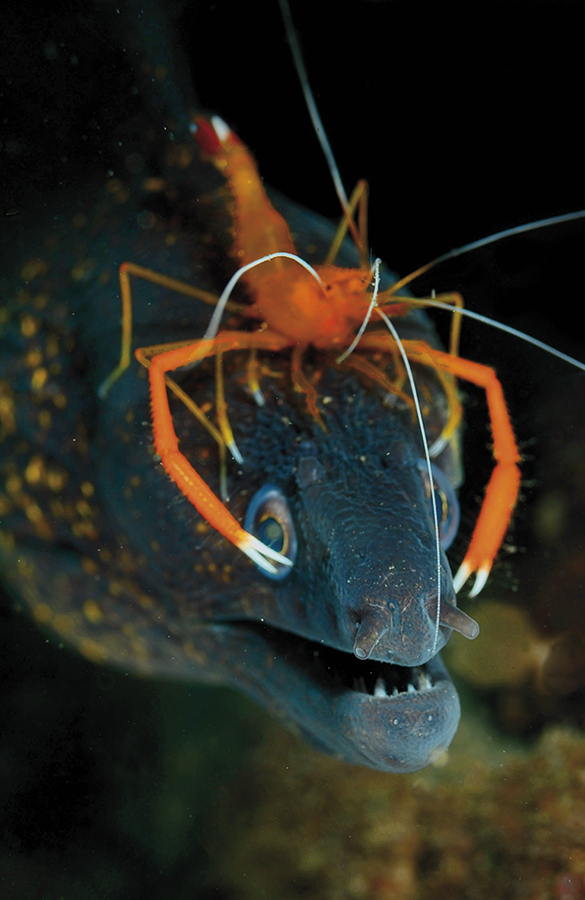
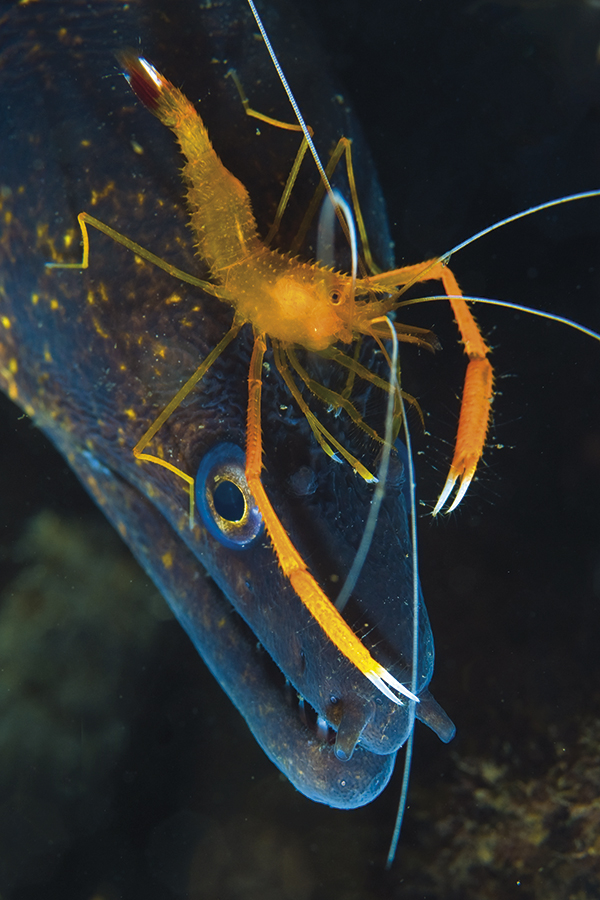
The absolute peculiarity of the situation portrayed is held by biologists as an “imitative” behavior. Here is the attempt by the “mechanical” shrimp (Stenopus spinosus), much larger than Lysmata, to take part to the banquet. So it happens in tropical seas, where the homologues of our Stenopus relate with bigger moray eels and succeed. This time it was not possible, and after the attempt the poor fellow came back into its den on an empty stomach.
(Scoglio del Vervece - Sorrento)
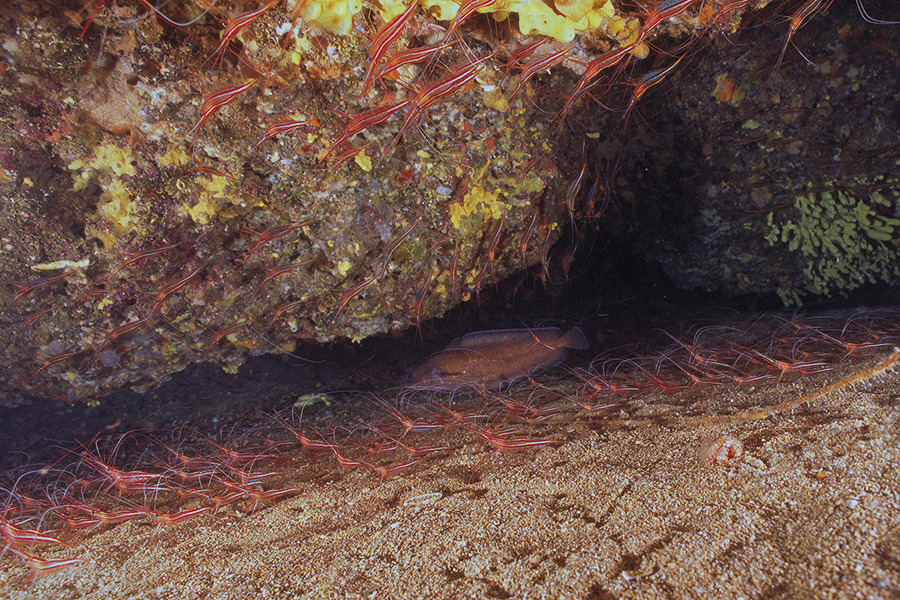 Appearances often deceive: one would not think that moray peacefully lives with shrimps, while “musdea” (Phycis phycis), a small fish with a peaceful look, is a
Appearances often deceive: one would not think that moray peacefully lives with shrimps, while “musdea” (Phycis phycis), a small fish with a peaceful look, is a
fearsome hunter: the placement of shrimps makes us think of the defensive lineup of an army during a battle. The shot was taken off the dry of Vatolla, in the marine park of Castellabate (Salerno), a place become fashionable after a well-known movie filmed a few years ago.
It is a very extensive seabed, technically called “bank”. The memory is special: I was about five miles from the coast. Around the boat there was only sea, no visual reference.
Below forty meters of blue and many rocks with red sea fans were waiting for me. The most unforgettable feeling a few other times I’ve proved, was of having an almost virgin place in front of my eyes. There is little talk of this sea on biological meaning, more for the archaeological and historical interest caused by wrecks, some of which dated back to the Second World War. Its marine life remains hidden under the waves.
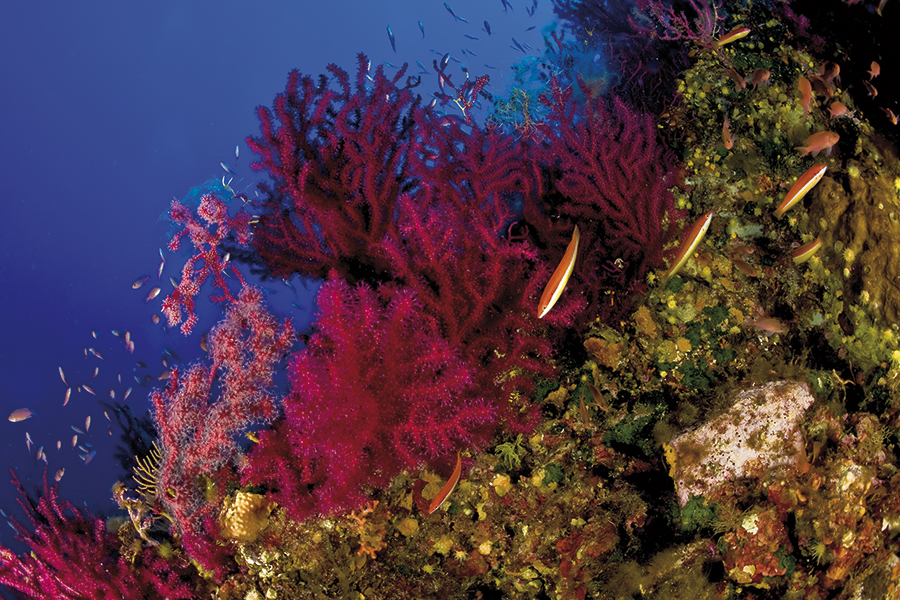 Soft corals are spectacular creatures, commonly found in tropical seas. Unlike most of octocorals they don’t have a skeleton. Splendidly flourishing in the Red Sea and Fiji Islands, they are quite rare in the Mediterranean Sea. The two specimens have an almost different biology. The almost unpronounceable Parerythropodium coralloides, recently renamed Alcyionium coralloides shows polyps recalling the ones of a red coral. It behaves as a parasite growing on the skeletons of other sea fans, and does not hesitate to kill them to ensure its own survival. (Stromboli – Messina)
Soft corals are spectacular creatures, commonly found in tropical seas. Unlike most of octocorals they don’t have a skeleton. Splendidly flourishing in the Red Sea and Fiji Islands, they are quite rare in the Mediterranean Sea. The two specimens have an almost different biology. The almost unpronounceable Parerythropodium coralloides, recently renamed Alcyionium coralloides shows polyps recalling the ones of a red coral. It behaves as a parasite growing on the skeletons of other sea fans, and does not hesitate to kill them to ensure its own survival. (Stromboli – Messina)
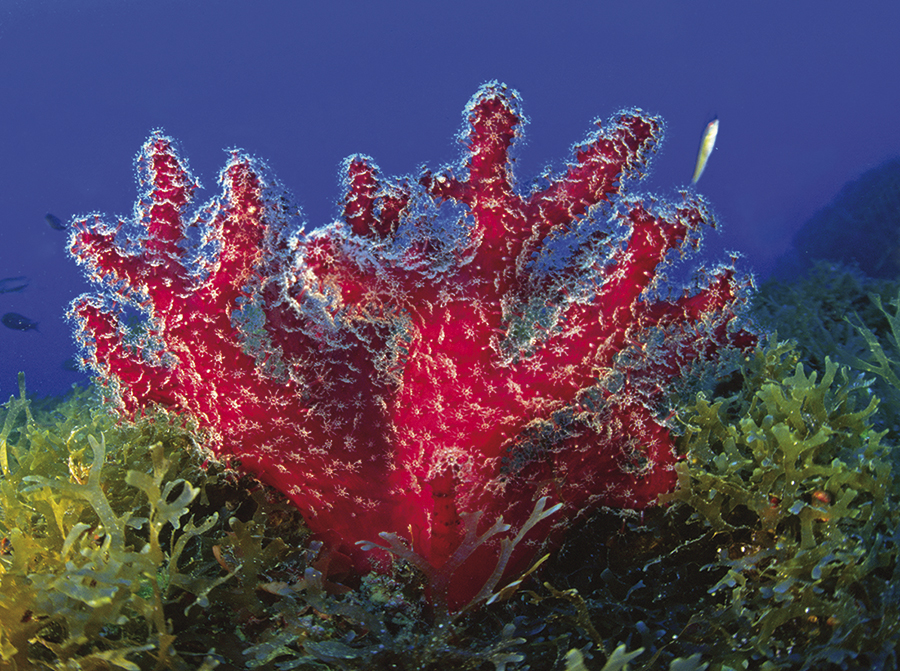
The Alcyonium palmatum, (see photo) like its tropical relatives, compensates for the lack of a skeleton by filling itself with water.
(Favignana - Trapani)
FROM - 134 TO -196 FEET (second session)
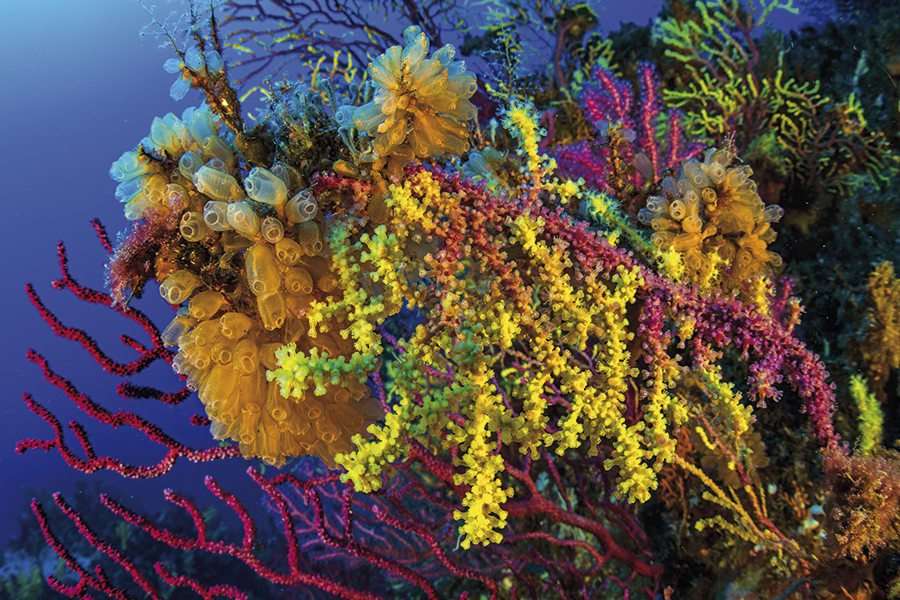
Clavelina lepadiformis are epibiont organisms, because, in addition tosettling on the rock such as on fishing nets irresponsibly left in the sea, they stick on others animals like tubes of the feather dust worms, sea fans, without predating them, just as in the shot. The only common fact is the passage of current. So there is no phenomenon of parasitism, in this event, because the Clavelina does not damage sea fans, at most they make them eat less, entering into competition with to grab the plankton particles. Pictures are really unmissable for photographers, as it seems to observe the branch of a multicolored fruit tree.
(Scilla - Reggio Calabria)
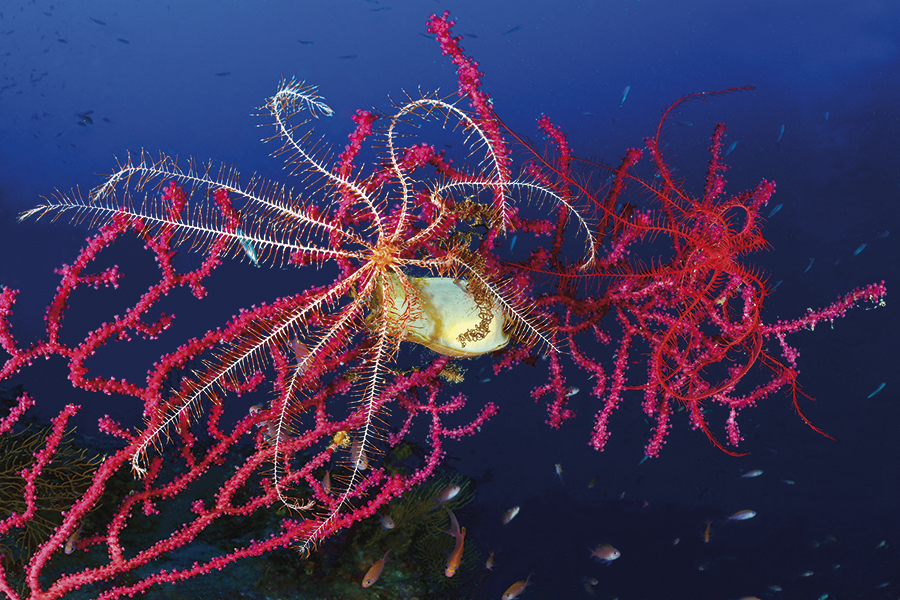
Mediterranean crinoids (Antedon mediterranea) usually move on other organisms to be able to capture plankton carried by the stream. They are echinoderms, and therefore relatives of sea stars, and they move easily on the coral. They do not have the color range of tropical ones, since they are brown, red or orange, and their arms move in the current looking for food. Theirs name means “sea lilies”, and it is curious to think that the resemblance to flowers was much more evident in Paleozoic era, when these creatures already inhabited sea planet.
(Praiano - Salerno)
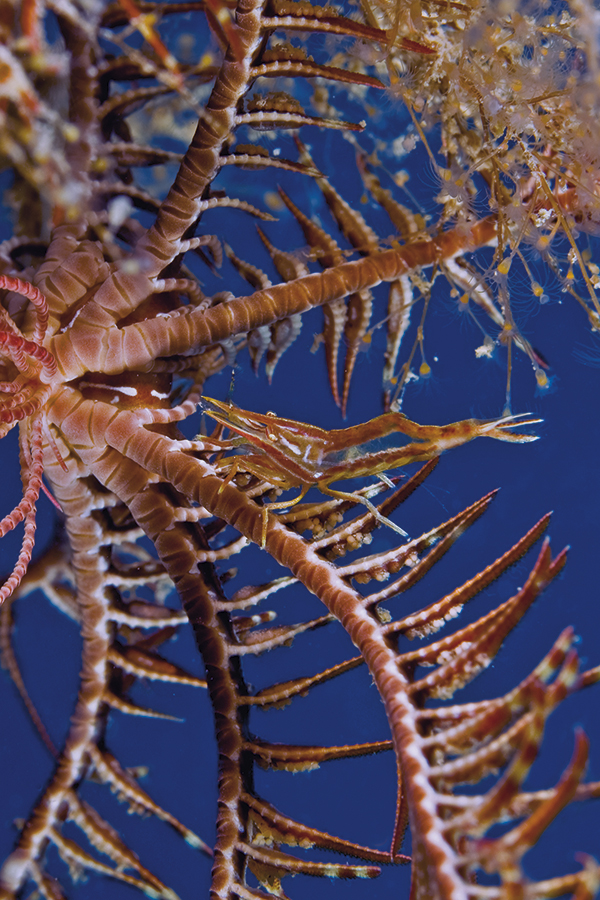
As it frequently happens, it is almost unknown relationship between crinoids and shrimps. Hippolyte prideauxiana hiddens by camouflaging itself to perfection in the arms of the
echinoderm. Almost certainly it is a “lodger” case, because, in addition to camouflage for obvious defensive issues, the shrimp also feeds of plankton particles escaping the food
conveying system used by the crinoids that is very similar to the one described for the Spirografi feather duster sea worms. Locating and framing the shrimp is deadly, unlike what it happens in the tropical seas, where, the presence of shrimps tenants is common and
systematic, and their research is definitely more feasible and full of satisfactions.
(Praiano - Salerno)
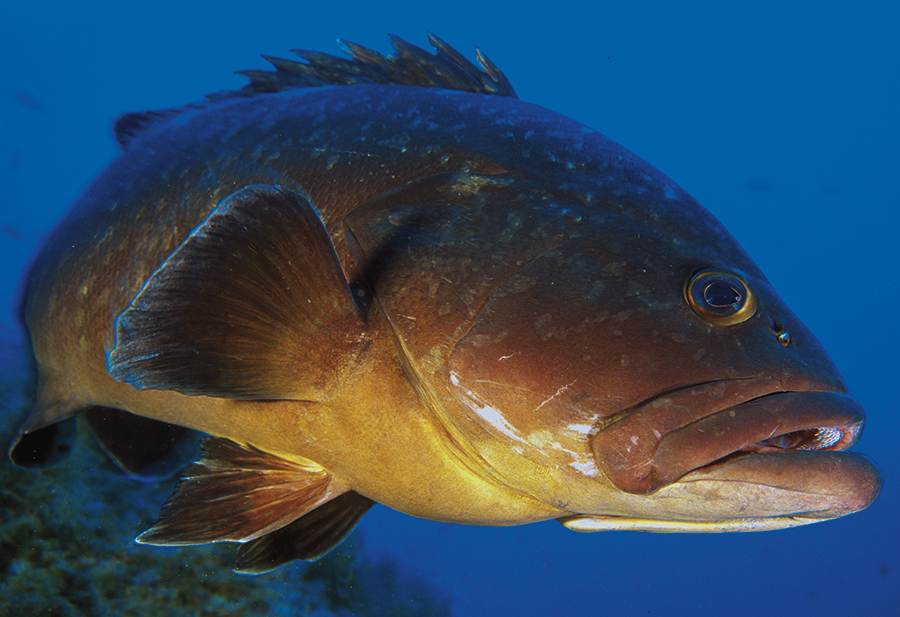 When, in the Mediterranean, along the walls or on the shoals offshore, one looks to the blue, almost always just sees...nothing but the blue. Fortunately there are surprises, and then emotions come thick and fast. In some marine parks, which are increasingly spreading in Mediterranean, close encounters with groupers (Epinephelus marginatus) are guaranteed.
When, in the Mediterranean, along the walls or on the shoals offshore, one looks to the blue, almost always just sees...nothing but the blue. Fortunately there are surprises, and then emotions come thick and fast. In some marine parks, which are increasingly spreading in Mediterranean, close encounters with groupers (Epinephelus marginatus) are guaranteed.
Marine parks, as well as turn out to be are business from an economic perspective is appreciated because it causes a natural repopulation of the water, on the other hand it often becomes a tourist industry and then a little predictable shows run.
The so-called fish-feeding, very popular in the tropical waters of Bahamas or Cayman islands where sharks, manta rays and other predators are actors, makes them accustomed in getting free food, instead of hunting it, with unfortunate effects on the delicate food chain.
(Medas Islands - Spain)
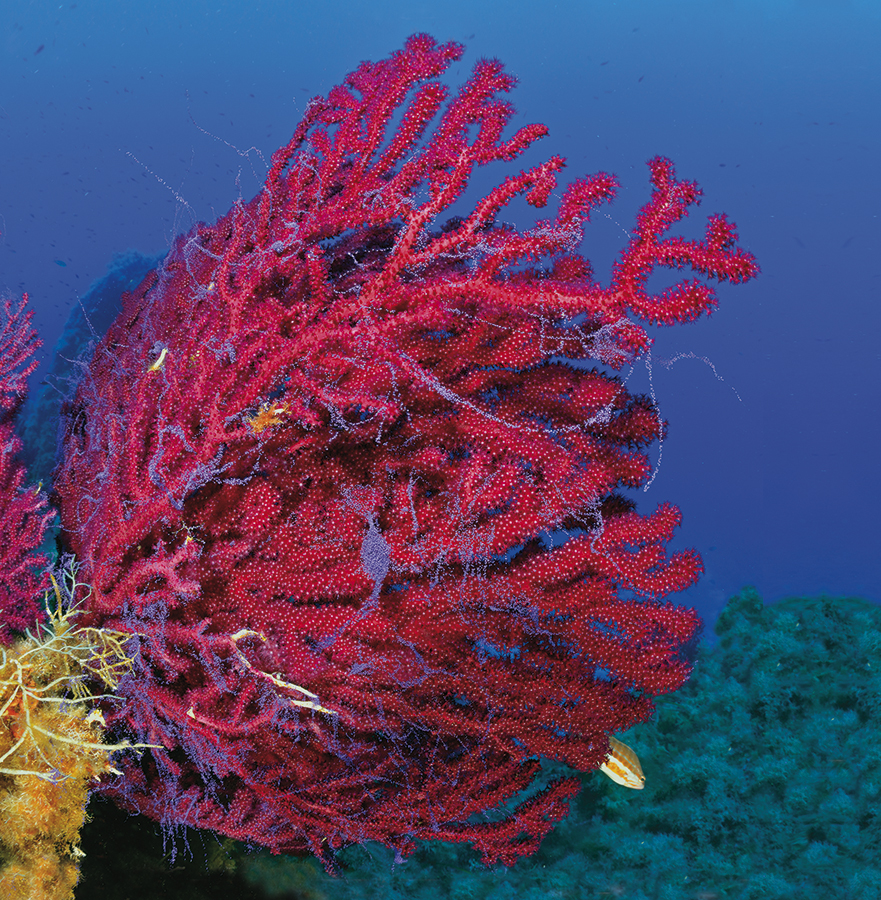 When you say luck... the red sea fans gametes are a very delicate lilac color, and are entrusted to sea. The ones finding stable dwelling on rock after having circled in the blue will give life to new colonies of individuals that will perpetuate the species. In tropical water is famous the “night of the corals” when, for a mysterious and magical date, madrepores emit eggs in the same time, and the black sea is colored by millions of new potentials beings. A show on the border with reality.
When you say luck... the red sea fans gametes are a very delicate lilac color, and are entrusted to sea. The ones finding stable dwelling on rock after having circled in the blue will give life to new colonies of individuals that will perpetuate the species. In tropical water is famous the “night of the corals” when, for a mysterious and magical date, madrepores emit eggs in the same time, and the black sea is colored by millions of new potentials beings. A show on the border with reality.
(Ustica - Palermo)
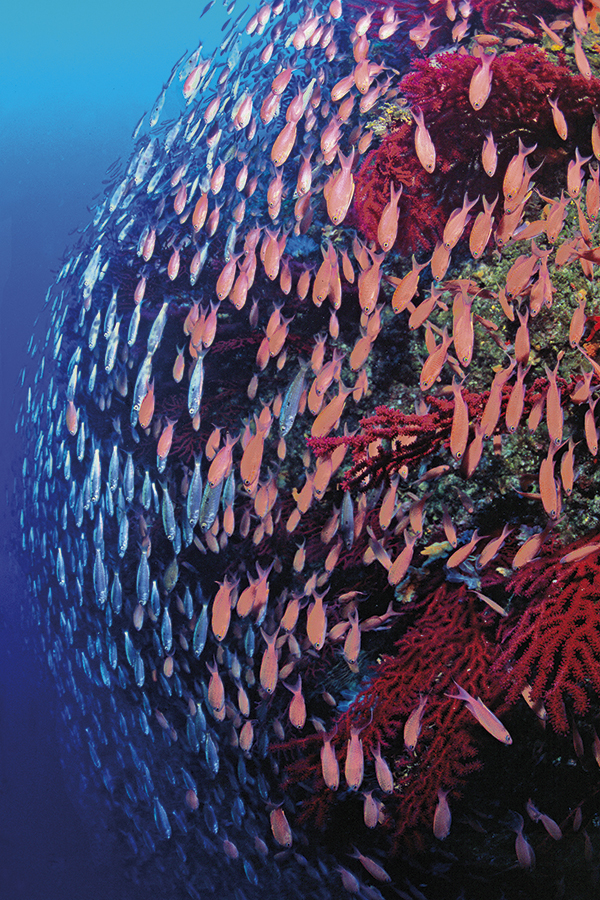
A fairytale show: the high concentration of deep damsel fishes (Anthias anthias) and zerri (Spicara smaris) in the middle of the sea fans is a very particular event.
The direction taken by the school facing the depth, lets us thinking of an escape from a predator, while the richness of color and concentration of specimens proves how much the life hidden under the waves is unknown, if compared to the external one, particularly when shows of this kind can be seen in very famous tourist places.
(Capri - Naples)
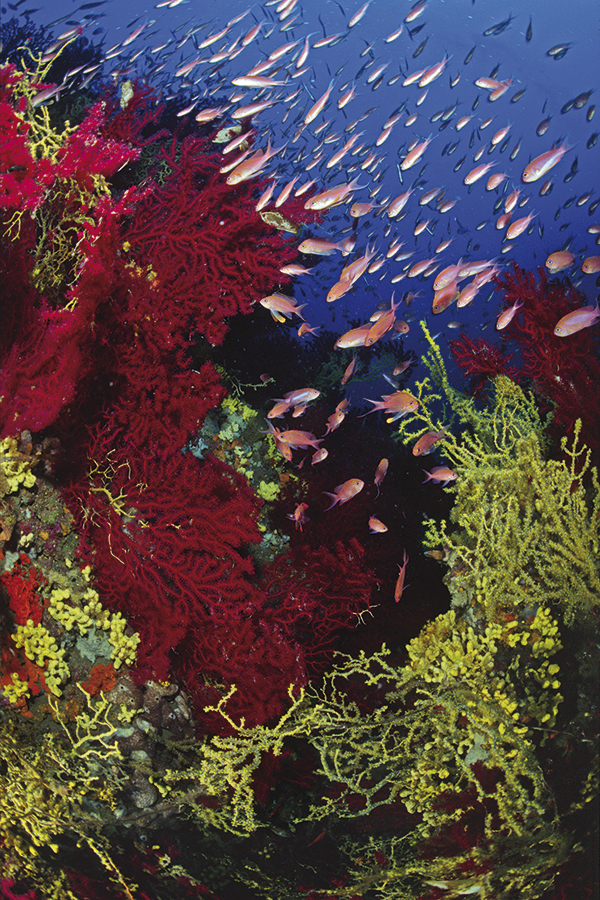
The false black coral (Savalia savaglia), although classified since the 1800s, it is a relatively recent discovery for divers. Accompanied by misfortune of that name - coral - the relative rarity of the organism, ignorance and greed, it was object of wild extirpation, in the false belief that “coral” it should be necessarily valuable.
Nothing could be more false. The internal skeleton of the coelenterate is black, it is very similar in structure to “true” Mediterranean black coral, the Antipathella subpinnata which lives at almost prohibitive depth for scuba divers. It’s an aggressive species, since it does not hesitate to settle with considerable speed on other organisms, both on the rock and on the wall, killing them and exploiting their skeleton. It is a behavior very similar to already met the soft coral Alcyonium coralloides.
(Castellammare di Stabia - Naples)
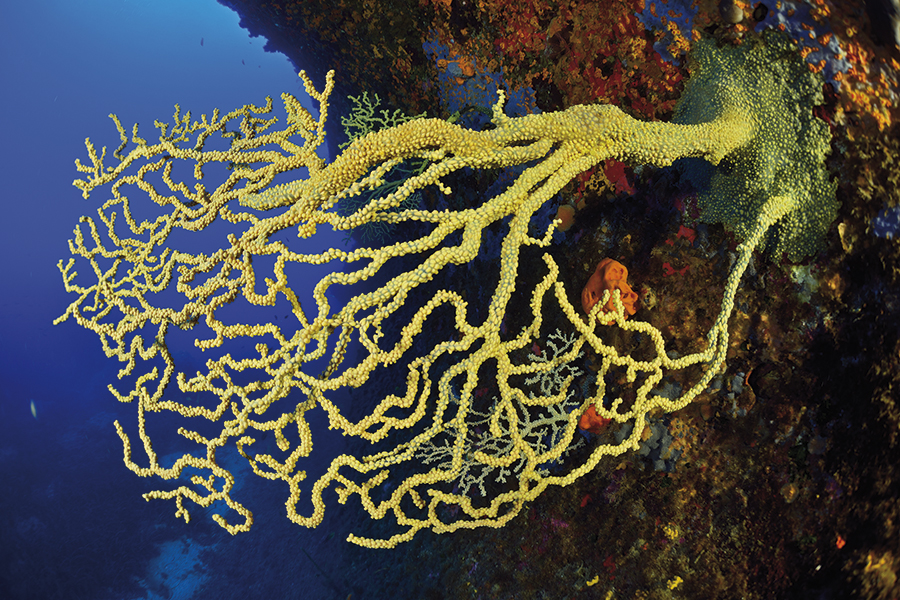 There are places where that feels like are taken directly out of imagination.
There are places where that feels like are taken directly out of imagination.
My friends in Ustica island had promised, a secret place, in the middle of the sea, a surprise for a few photographers. The honor to be one of these, which is counted on the fingers of one hand. I find myself on board of the boat, it is told to me to dive 007 action style while boat is sailing not let anybody understand the secret site. I see a really little interesting seabed, beyond an exterminated Posidonia grass and some secluded rocks. In the distance one like many, but my friend Giulio looks out from the other side and signals me to follow him. So do I, and I realize that an almost bare rock, with no trace of any coral all around, who knows for what devilry only Neptune knows, have grown five branches of false black coral in rapid succession. They are huge, and I realize my technical photo limits: it is optically impossible to take them. Only a video could make the idea of these yellow trees literally planted in the rock, solitary giants, and jewels of an unexplored reign, in a clarity of tropical paradises reef.
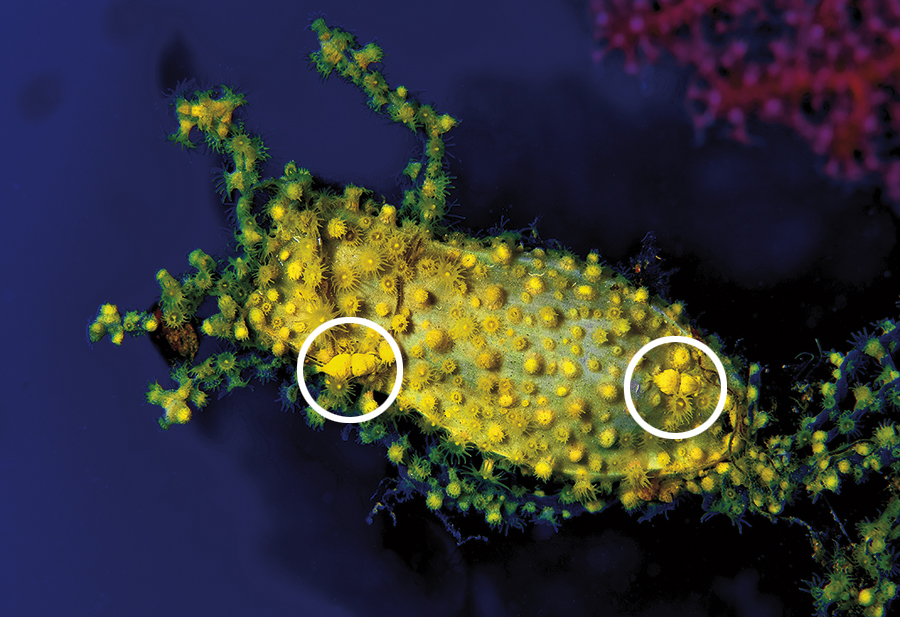
An example of the tendency of the organism to settle on structures already present is given by these two shots, where you can see the shell of sea nursehound egg totally covered by the polyps of Savalia savaglia.
A detail that escapes observers, including the author of the shot, (by this shot) is that among of the polyps two Ballsia gasti, tiny shrimps unknown to most are sitting (lower left and upper right). They are a rare meeting, and live among the polyps of the sea fans, reaching an absolutely perfect level of camouflage.
(Praiano - Salerno)
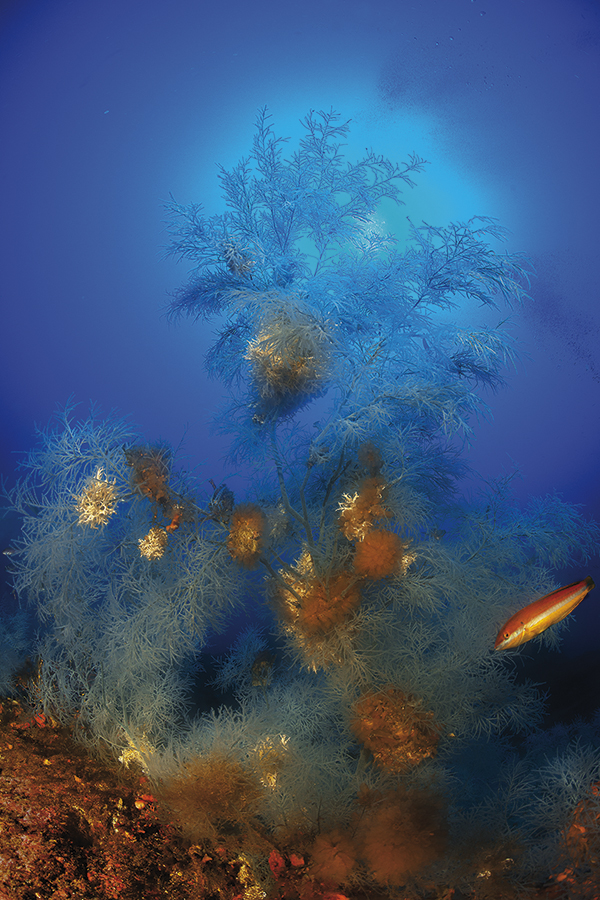
And here it is the “true” black coral (Antipathella subpinnata), a species that has tropical counterparts, particularly in the Red Sea. Reported in a few places in the Mediterranean, because, as mentioned, it lives at prohibitive depths, it’s very different than sea fans, either as a structure, as a morphological aspect: it looks like a tree, and unlike the so-called “Octocorals”, like red coral, whose polyps have eight tentacles, the Antipathella only counts six. Various organisms are placed in the middle of the branches like bivalve mollusks, tunicates and worms.
It often grow on the wall, but, just like trees, it grows on horizontal rocks.
Scientists believe that black coral is the oldest animal creature alive in the world, as some colonies they would be a thousand years old, that is another element of absolute charm.
In Scilla, over 60 meters deep, on a seabed, it was discovered the largest colony of antipaters so far reported in the Mediterranean, and a few people had the chance to see it.
The show is unforgettable since you have the feeling to be in the middle of a snowy forest at the bottom of the sea, a surreal landscape that no photograph will be able to return with acceptable satisfaction.
(Scilla - Reggio Calabria)
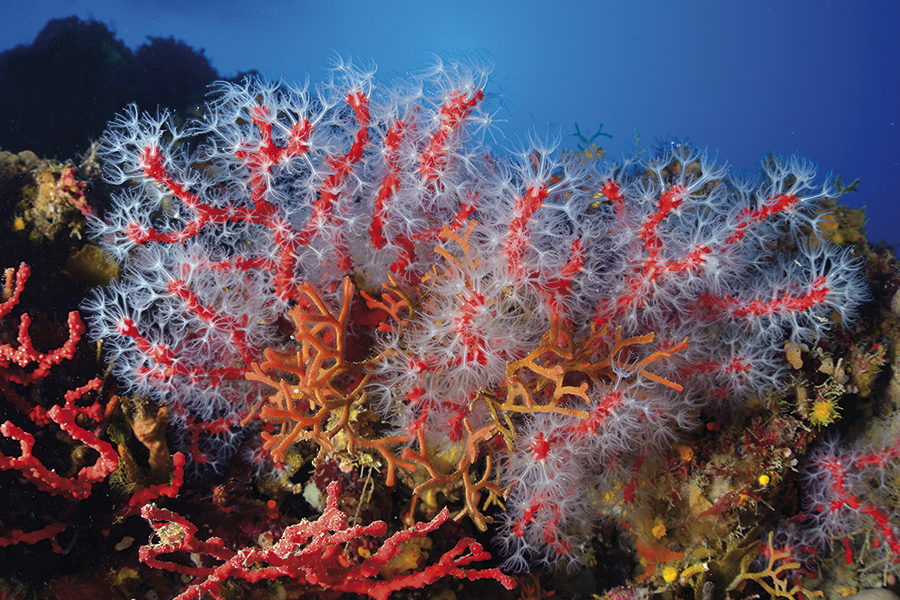 The red coral (Corallium rubrum) is the most precious and wanted Mediterranean coral. It is an endemic species. it was object of unbridled fishing in the 60s when it was triggered a real race to the “red gold”, as it was called.
The red coral (Corallium rubrum) is the most precious and wanted Mediterranean coral. It is an endemic species. it was object of unbridled fishing in the 60s when it was triggered a real race to the “red gold”, as it was called.
It was a pioneering era for compressed air scuba diving. The largest branches were really suitable for processing, to be turned in fantastic jewels. They were often found above 328 feet depth. The richest places were in Sardinia and along the French coast, and many deep sea divers of the time underwent incredible stress and risk, just to secure the more beautiful and precious branch.
A few really found wealth; many of them were fame for theirs courage and for being the first to break down the wall of 328 feet, but as always it happens when one goes beyond the limits, the sea asked for a heavy tribute. Its beauty is indisputable, especially when polyps are out and with the their pale white color almost cover the red body.
(Palinuro - Salerno)
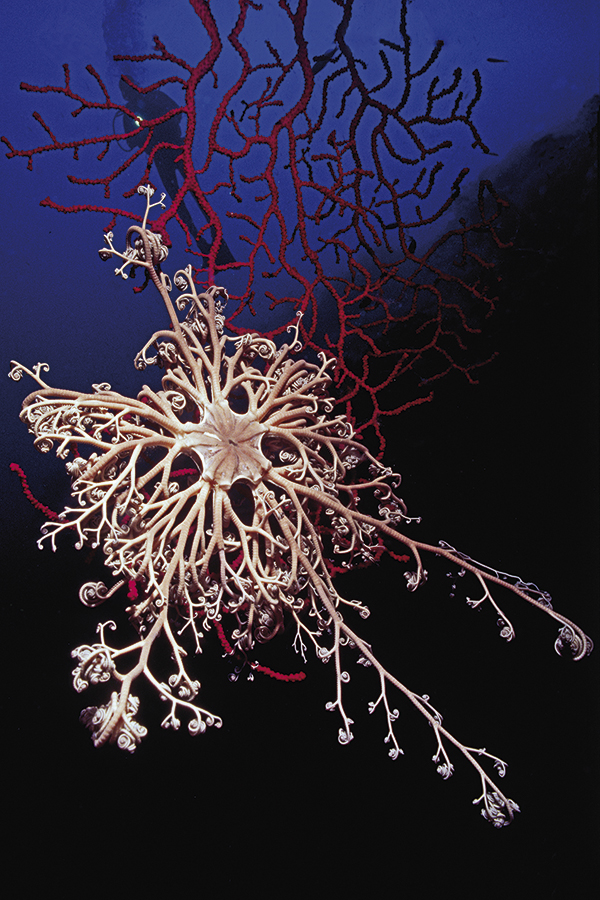
Gorgonocephalus basket sea star, (Astrospartus mediterraneus), is a very evocative name for a wanted and elatively rare animal. It has typical nocturnal habits, because night time it extends its arms hunting for plankton, like the homologous tropical species.
For many years Its presence has been reported almost exclusively along the deep and deep coasts and islands of the Tuscan archipelago and its surroundings. Today, because of one of those mysteries little is spoken about it was increasingly spread, and moreover less deep.
It is scientifically quite strange, also because the progressive warming of the water - it was thought that the rarity was given by loving animal relatively low temperature - would have led to the opposite behavior. Daytime it is however very rare finding the animal even partially open. The shot was taken on the wall called “sacco di titta” in Giglio island, and it is the result of some lucky circumstances: because of the late afternoon hour, and depht - 175 feet - the star was almost open, sìnce the light of the environment tended more to black than to the blue. Besides that place was not popular, and allowed a relative quiet to these very shy animals. That time stillness was broken by the photographer, in fact, basket sea star in a few seconds moved, reached the bottom of the sea fan it was clinging on and dropped a few feet more down to close immediately.
Granted time to me was a few seconds, granted shots were two. (Giglio island- Grosseto)Gorgonocephalus basket sea star, (Astrospartus mediterraneus), is a very evocative name for a wanted and elatively rare animal. It has typical nocturnal habits, because night time it extends its arms hunting for plankton, like the homologous tropical species.
For many years Its presence has been reported almost exclusively along the deep and deep coasts and islands of the Tuscan archipelago and its surroundings. Today, because of one of those mysteries little is spoken about it was increasingly spread, and moreover less deep.
It is scientifically quite strange, also because the progressive warming of the water - it was thought that the rarity was given by loving animal relatively low temperature - would have led to the opposite behavior. Daytime it is however very rare finding the animal even partially open. The shot was taken on the wall called “sacco di titta” in Giglio island, and it is the result of some lucky circumstances: because of the late afternoon hour, and depht - 175 feet - the star was almost open, sìnce the light of the environment tended more to black than to the blue. Besides that place was not popular, and allowed a relative quiet to these very shy animals. That time stillness was broken by the photographer, in fact, basket sea star in a few seconds moved, reached the bottom of the sea fan it was clinging on and dropped a few feet more down to close immediately. Granted time to me was a few seconds, granted shots were two.
(Giglio island- Grosseto)
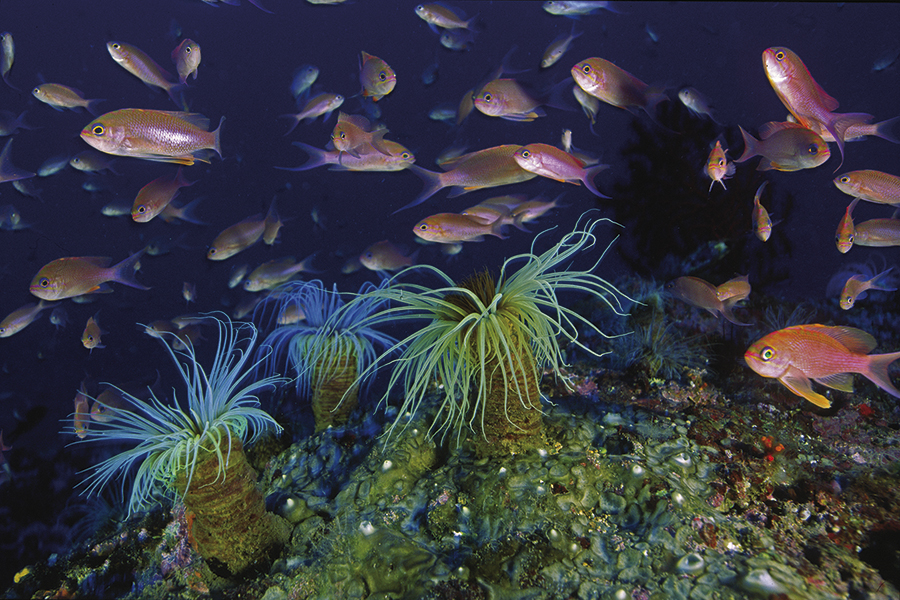
Although it is a widespread species, Cerianthus membranaceus is endemic to the Mediterranean. It is an elegant and typical inhabitant of the sand and mud, and at first sight it would seem a close relative of the “spirografo” feather worms, because of its tentacles floating in the current, and the tube where it withdraws if disturbed. Really it is a coelenterate, similar to to sea fans and corals. It lives from a few feet to more relevant depths, and it is very unusual meeting it on the rock, as in the shot, surrounded by
sponges and pink damselfishes. During nightime we’ll meet a very particular and rare cerianth, living just on mud slopes.
(Castellammare di Stabia - Naples)
 Meeting barracudas (Sphyraena viridensis cuvier) schools is always spectacular and unforgettable. The shots were taken at Ustica, held as the Mediterranean tropics.
Meeting barracudas (Sphyraena viridensis cuvier) schools is always spectacular and unforgettable. The shots were taken at Ustica, held as the Mediterranean tropics.
Individuals are not very large, unlike tropical relatives, and more tapered, but their evolutions are breathtaking. They create synchronous movement, vortexes, circles, pyramids, and seem a living geometry book… (photo on the side and next page).
As it often happens in nature, this behavior is not accidental, as it is aimed at a hunting strategy.
(Ustica - Palermo)
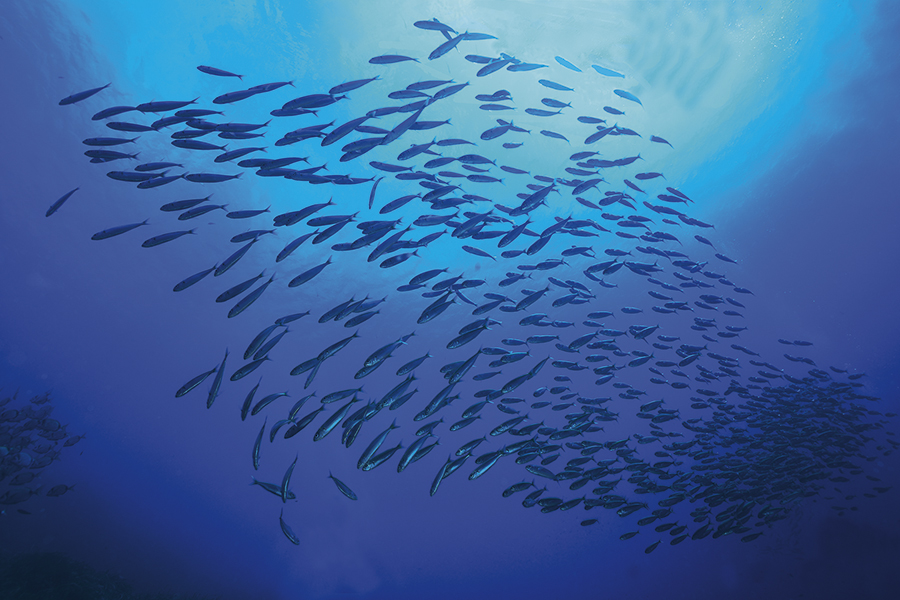 How do potential hunted react? In the same way, and if possible, even more cunning and expertise. They are aware that isolating, as they induce to make bigger fish, they would be hopelessly losers, in turn they gather in thick packs to appear bigger than they really are.
How do potential hunted react? In the same way, and if possible, even more cunning and expertise. They are aware that isolating, as they induce to make bigger fish, they would be hopelessly losers, in turn they gather in thick packs to appear bigger than they really are.
This creates misunderstanding in predators, and guarantees chance of salvation for individuals who are at the center of the of the school, and survival of the species.
In the picture, the pack of bogues (Boops boops), to the delight of the photographer, swims towards his lens. With a little bit of fantasy, its shape could be taken for a big fish…
(Ustica - Palermo)
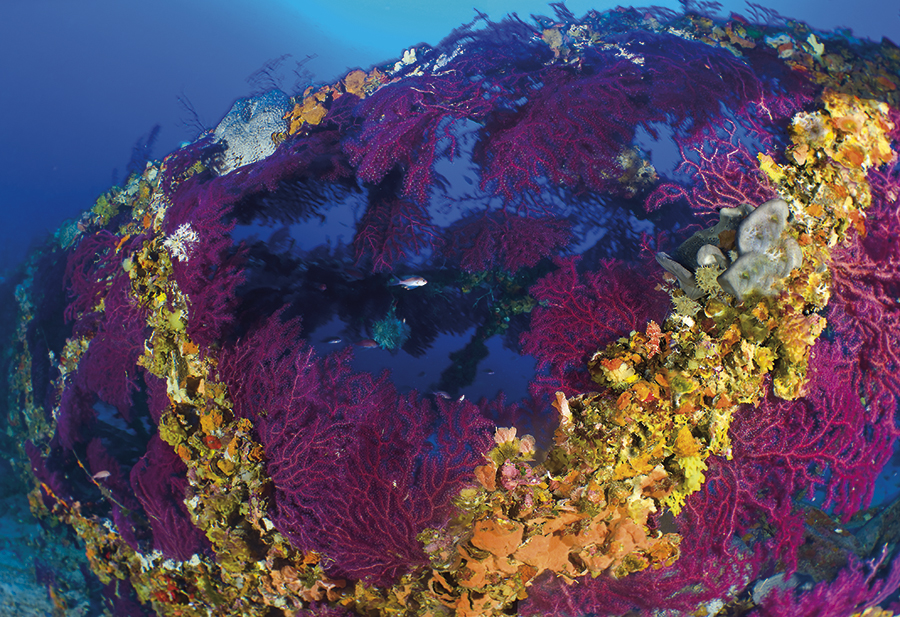 How do potential hunted react? In the same way, and if possible, even more cunning and expertise. They are aware that isolating, as they induce to make bigger fish, they would be hopelessly losers, in turn they gather in thick packs to appear bigger than they really are.
How do potential hunted react? In the same way, and if possible, even more cunning and expertise. They are aware that isolating, as they induce to make bigger fish, they would be hopelessly losers, in turn they gather in thick packs to appear bigger than they really are.
This creates misunderstanding in predators, and guarantees chance of salvation for individuals who are at the center of the of the school, and survival of the species.
In the picture, the pack of bogues (Boops boops), to the delight of the photographer, swims towards his lens. With a little bit of fantasy, its shape could be taken for a big fish…
(Ustica - Palermo)
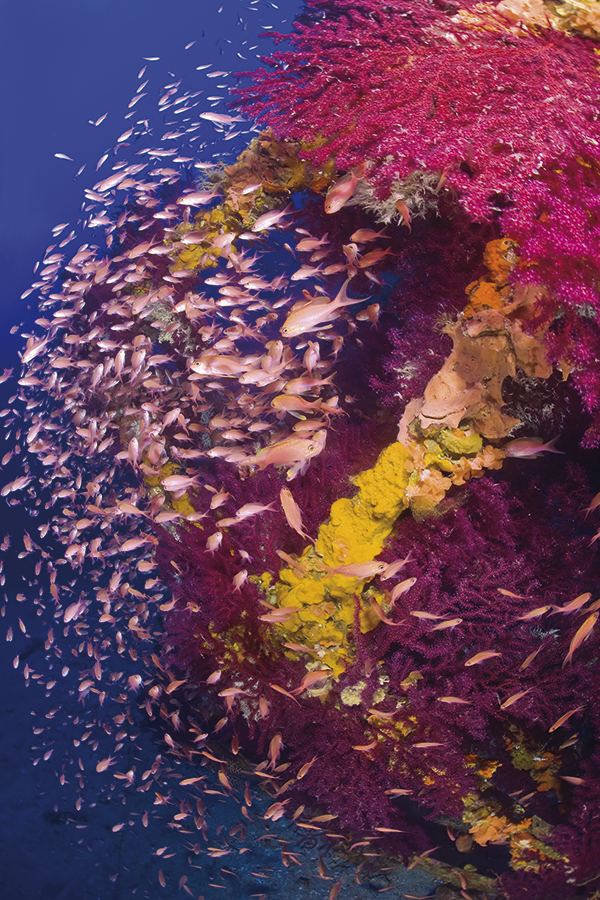
In this case an old antenna fell into the sea, and lies on the sand 216 feet deep. It is constantly shrouded by a cloud of pink damsel fishes. By the way on the sand, wrongly
considered desert territory, begins a new part of the journey.
(Capri - Naples)
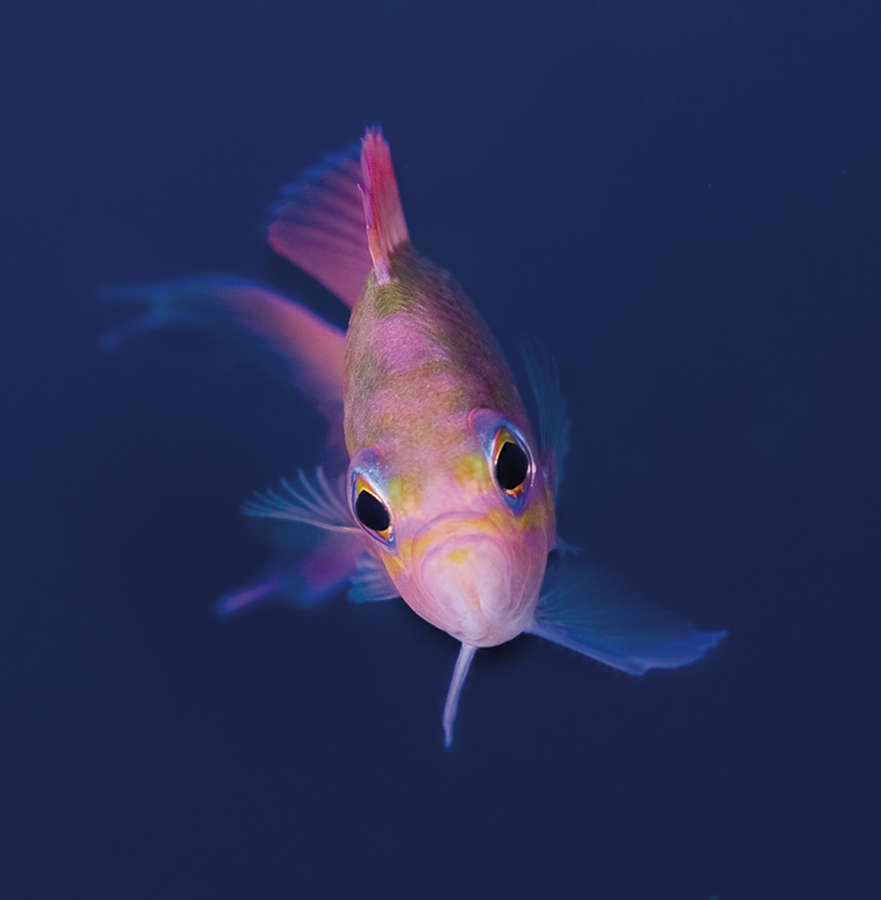
... While a solitary specimen of pink damsel fishes (Anthias anthias) it looks sulky. Perhaps it turned far away from the school and scared by the arrival of the photographer, it seems to show sorrow to… Damsel fishes change sex during their life according to the needs of the community, so they are hermaphrodites. Tropical damsels, living along reef, are very similar to Mediterranean ones. The most common have typical orange shades, in place of pink ones.
(Corfù - Greece)
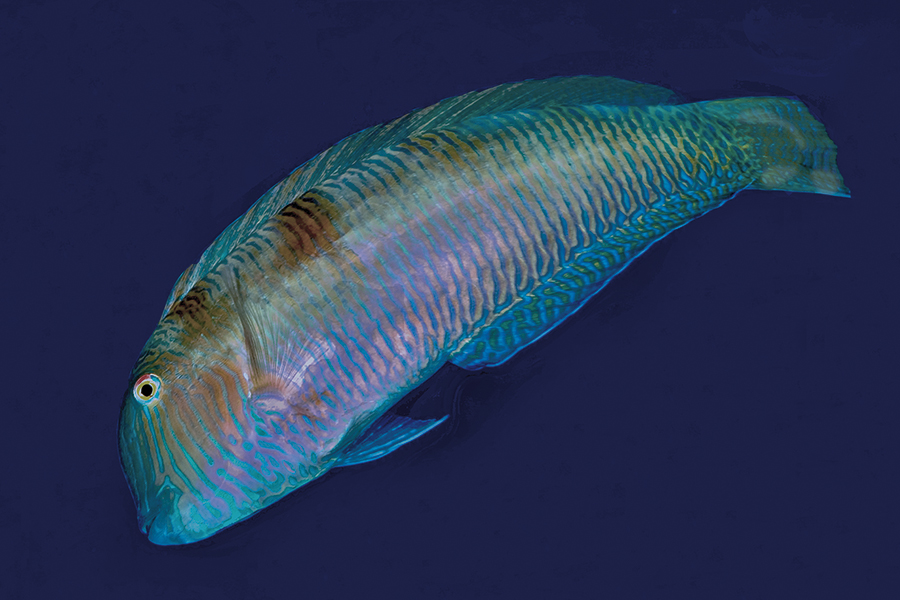 And what better welcome for those who believe that the sandy bottoms are not very interesting? The cleaver wrasse (Xyrichtys novacula) hardly lets itself get close and does not hesitate to throw itself head in the sand, without even saying goodbye, but if you can frame it in the blue, the shot will reveal beautiful lines and colors. Shades are many, from red to green to blue, but magnificent, especially those of the male specimens in the reproductive period.
And what better welcome for those who believe that the sandy bottoms are not very interesting? The cleaver wrasse (Xyrichtys novacula) hardly lets itself get close and does not hesitate to throw itself head in the sand, without even saying goodbye, but if you can frame it in the blue, the shot will reveal beautiful lines and colors. Shades are many, from red to green to blue, but magnificent, especially those of the male specimens in the reproductive period.
A true inhabitant of the tropics mistakenly come in the Mediterranean?
(Puolo bay - Sorrento)
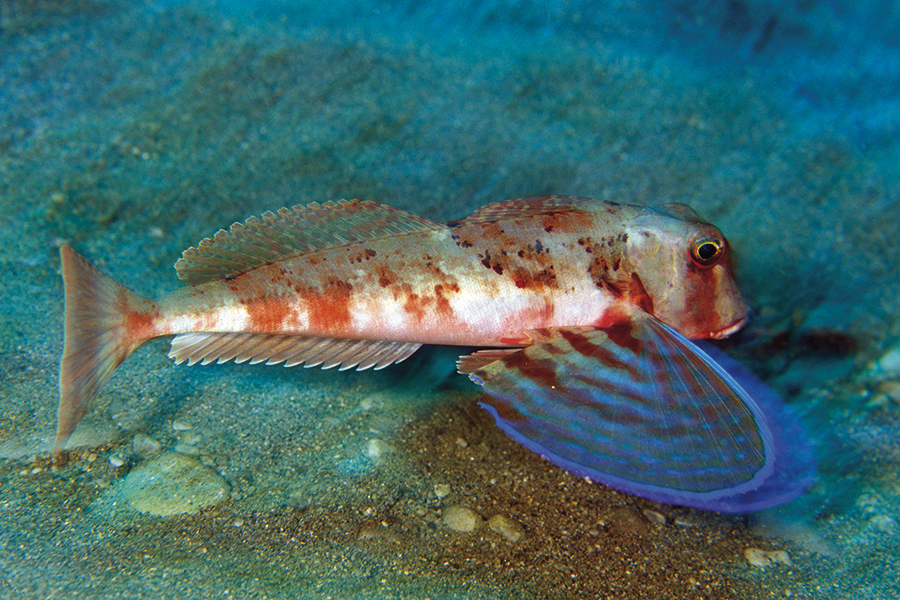 Gurnard (Chelidonichthys lucerna) is a typical and elusive inhabitant of the sand, such as many shy guys is always ready to give you its tail... In next shot, where the dark background was got in post procession step, you can value the outstanding electric blue of the border. Particularly wanted because of its tasteful meats, it is not less appreciated by photographers,
Gurnard (Chelidonichthys lucerna) is a typical and elusive inhabitant of the sand, such as many shy guys is always ready to give you its tail... In next shot, where the dark background was got in post procession step, you can value the outstanding electric blue of the border. Particularly wanted because of its tasteful meats, it is not less appreciated by photographers,
especially because of bright colors of the great pectoral fins, used as a rudder and stabilizing wings, just like the planes, while swimming fast. It is interesting to know that, under normal conditions, fish literally walks on the sandy bottom using the thorny ends of the pectoral fins themselves. We shall try to understand why during night time session, when we’ll meet it again together with an other specimen, the owl fish, that has similar features.
(Praiano - Salerno)
TOWARD THE LIGHT (third session)
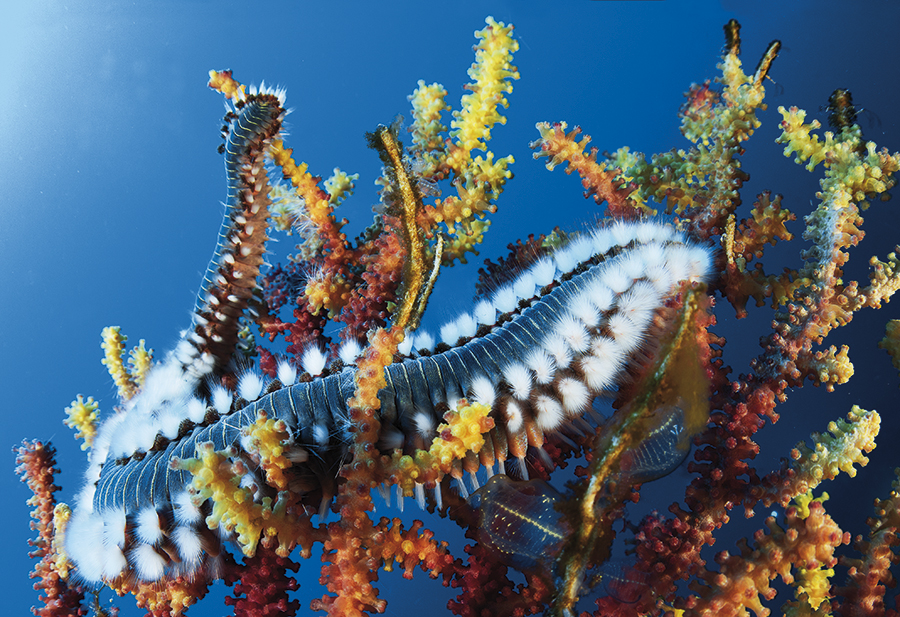 The fire worm (Hermodice carunculata) looks like a centipede, more than a worm. It’s a typical inhabitant of the warm waters and it is the most common species in the Mediterranean. External tufts are real weapons, because of the strong stinging power.
The fire worm (Hermodice carunculata) looks like a centipede, more than a worm. It’s a typical inhabitant of the warm waters and it is the most common species in the Mediterranean. External tufts are real weapons, because of the strong stinging power.
They are fascinating and dangerous. Its biology is interesting and worrying: it is omnivorous - often performing the ecological function, feeding on the carcasses of dead animals - it is
increasingly expanding its spread from the southern waters of the Mediterranean to the northern ones.
As the picture eloquently testifies, it also feeds on the polyps of the sea fans. It is constantly increasing, so that in the short term it could become a biological and environmental emergency for Mediterranean corals.
(Scilla - Reggio Calabria)
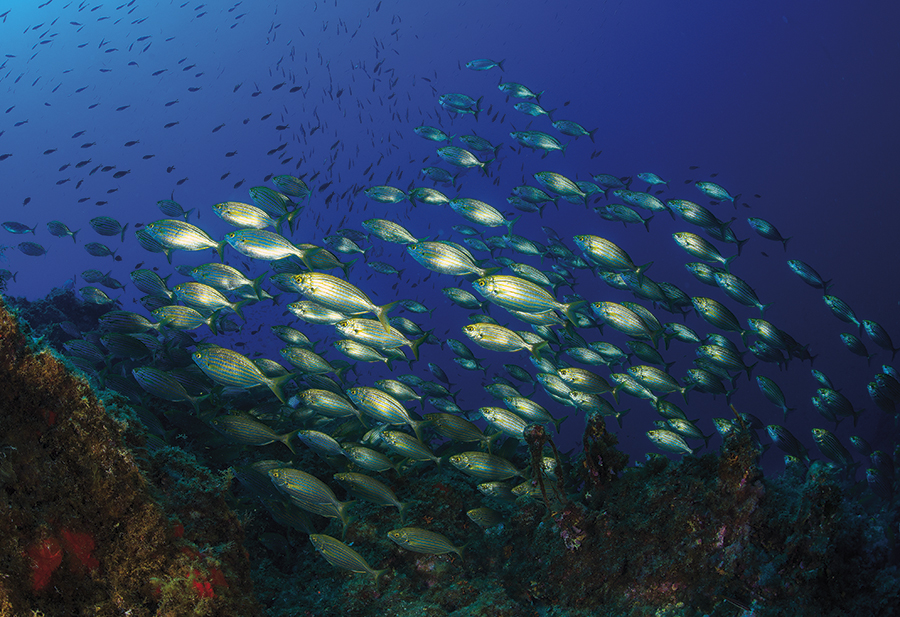 Climbing up the wall to more accessible depths, the school of salps (Sarpa salpa) comes across to welcome us back. They are majestic and at first impact they seem a school of tropical jacks, smaller but with a more attractive livery.
Climbing up the wall to more accessible depths, the school of salps (Sarpa salpa) comes across to welcome us back. They are majestic and at first impact they seem a school of tropical jacks, smaller but with a more attractive livery.
Goldlines are not a much sought after fishes, as they feeds on algae and small invertebrates. Their meats are not particularly tasty. Talking about it, a real urban legend was born according to which the meat of the goldlines, and the head in particular, would have
hallucinogenic effects similar to the ones produced by LSD lysergic acid. This would be caused by a particular alga they feed of, that could contain psychedelic toxins. Even the Romans in ancient times would have been consumers of goldlines to “benefit” from its side effects. Ironically, many people wonder if it is a market strategy to increase the consumption of goldlines…
(Scilla - Reggio Calabria)
The Britoi nudibranch (Felimida binza) is held as very rare. I don’t know if a courtship was in progress when I met them. I was surprised when I discovered that others two specimens were below the rock covered with sponges. Finding four binza at the same time, besides being a good shot of luck, it makes the question arise if it might be a nudibranch with gregarious habits.
(Puolo bay - Sorrento)
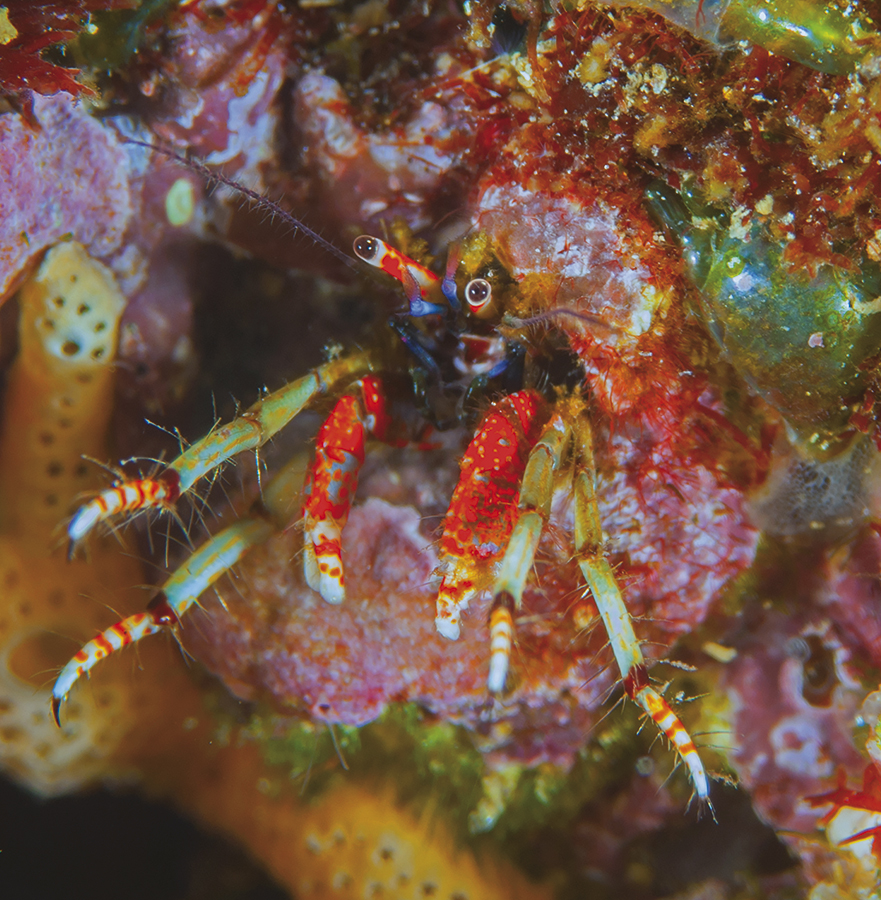
If the tubeworm hermit crab (Calcinus tubularis) is probably the most unknown among hermit crabs, unquestionably it is the most beautiful and colorful, perhaps the symbol of a sea as Mediterranean, accessible to everyone but escaping the attention of almost all.
Its feature it takes is name “sedentary” is that it rarely occupies left shells of mollusks he comes in to make them its shelter and home. In fact, because of its really very tiny size, it is usual to occupy the calcareous pipes left free by very small stationery worms, it permanently settles in. It protrudes from the tube in search of particles of micro plankton.
The genus Calcinus is widespread in tropical seas. The species is among the most wanted by photographers and aquarists: the most famous is the C. elegans, that is larger, and gets fantastic electric blue paws and mottled eyes.
(Giglio island - Grosseto)
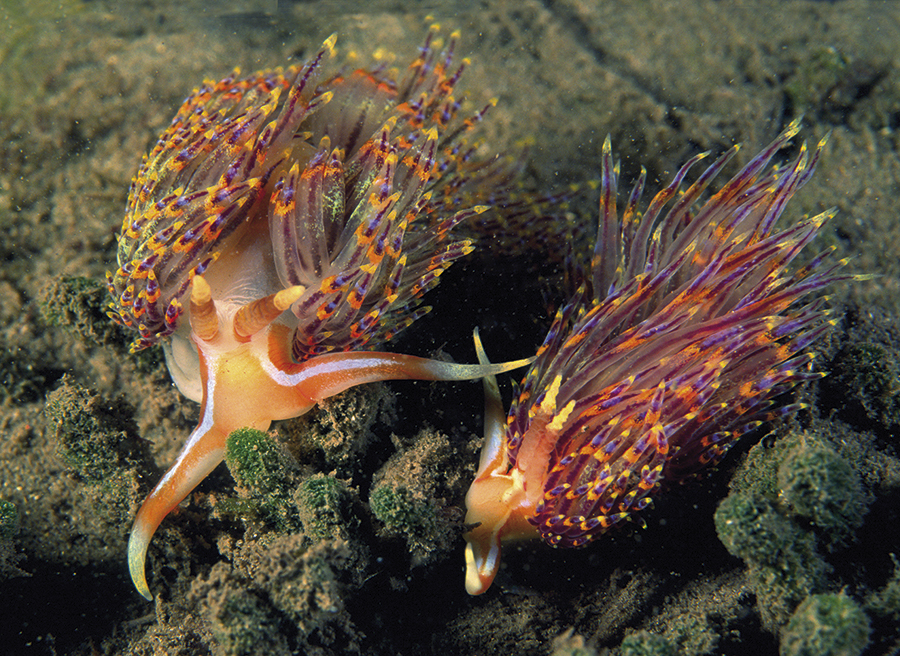 In the salt marshes waters, we can meet this wonderful nudibranch specimens.
In the salt marshes waters, we can meet this wonderful nudibranch specimens.
You can find them only searching in micro-environments they live in. Long identified as Facelina coronata, Naples marine biologists recently reclassified it recognizing it as Godiva quadricolor. I always think about their faces when they knew that such species also lives in Australia and South-Africa...
(Fusaro lagoon - Naples).
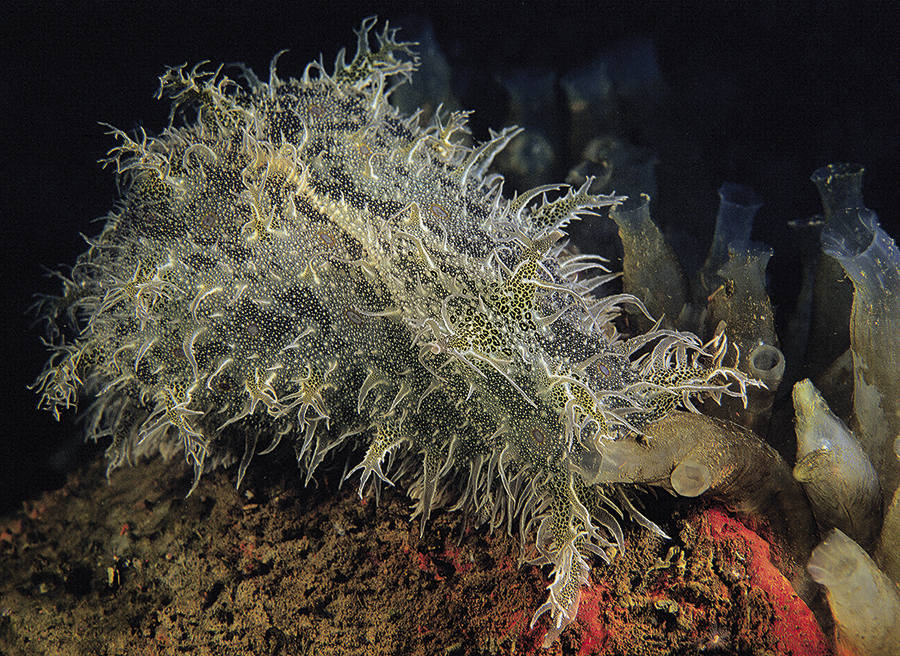 The Bursatella (Bursatella leachii) is a classic opistobranch coming from Lesseps channel, Red Sea. It was relatively rare, surely beautiful because of its blue rings and multicolored streaks all over the mantle when it is stressed, recalling the tropical blue ring octopus. It is mostly found in central-southern waters. A scientific curiosity is that it is really similar to the Aplisia, but it belongs to the different family of the notarchids.
The Bursatella (Bursatella leachii) is a classic opistobranch coming from Lesseps channel, Red Sea. It was relatively rare, surely beautiful because of its blue rings and multicolored streaks all over the mantle when it is stressed, recalling the tropical blue ring octopus. It is mostly found in central-southern waters. A scientific curiosity is that it is really similar to the Aplisia, but it belongs to the different family of the notarchids.
(Fusaro lagoon - Naples)
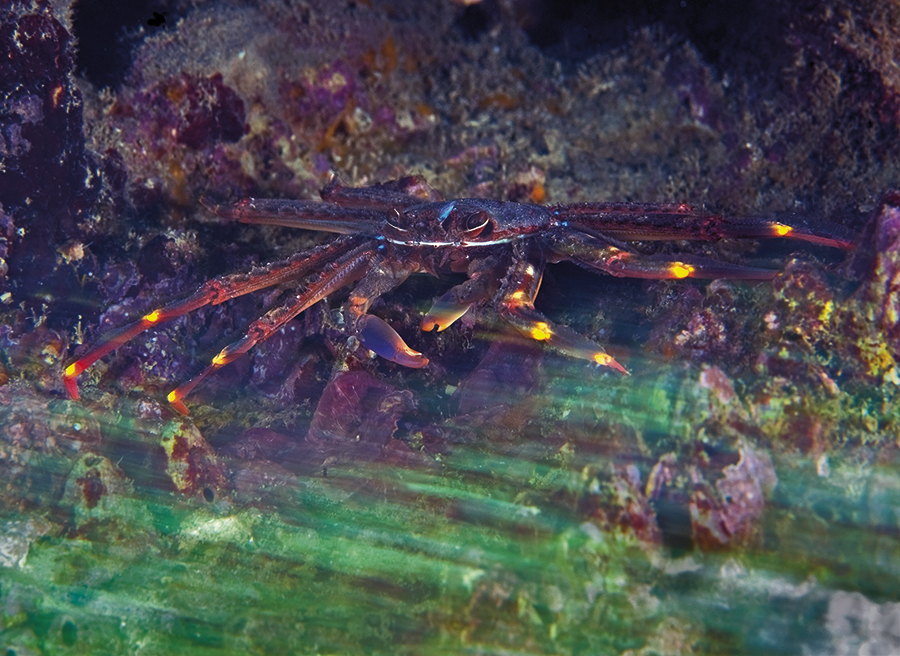 The so-called “runner crab” (Percnon gibbesi) is instead an alien coming from the other opening that makes the Mediterranean a sea, instead of a lake: Gibraltar Strait.
The so-called “runner crab” (Percnon gibbesi) is instead an alien coming from the other opening that makes the Mediterranean a sea, instead of a lake: Gibraltar Strait.
It comes from Senegal, and it invaded shallow rocky waters, but, living up to its italian name, it is extremely fast to disappear, in front of the diver.
(Praiano - Salerno)
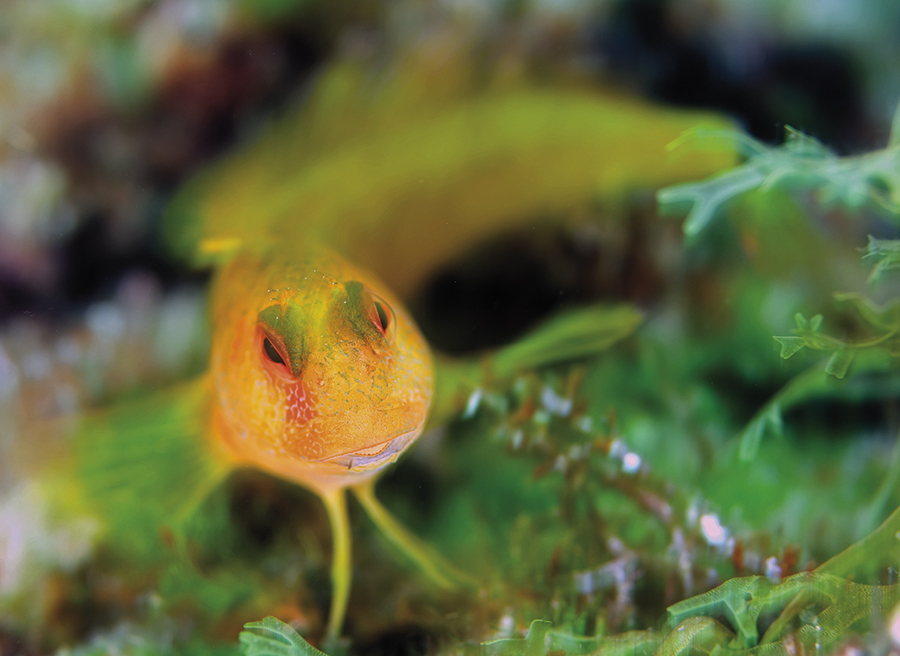 The African blenny (Parablennius pilicornis) comes from Atlantic ocean too. It was relatively rare until a few years ago, but nowadays it has permanently settled along the european coasts and it’s an almost guaranteed and extremely pectacular meeting because different colors it can take, the classic yellow ...
The African blenny (Parablennius pilicornis) comes from Atlantic ocean too. It was relatively rare until a few years ago, but nowadays it has permanently settled along the european coasts and it’s an almost guaranteed and extremely pectacular meeting because different colors it can take, the classic yellow ...
(Syracuse)
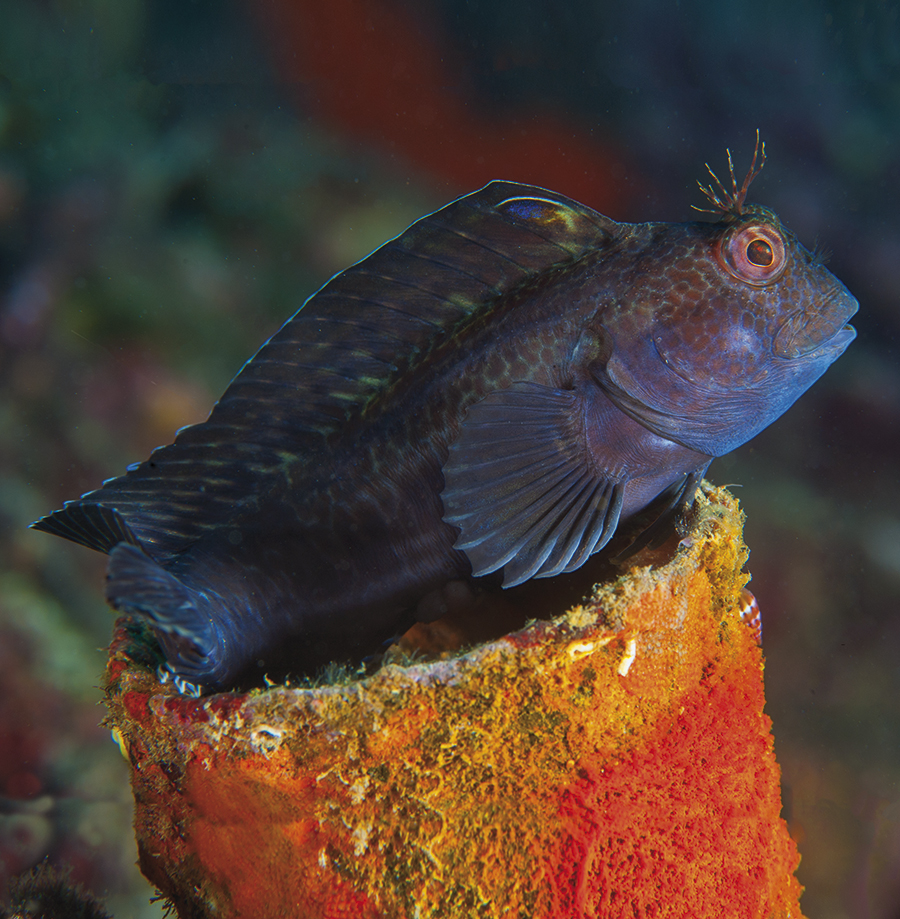 ... the less common blue one, taken while it seems a sentinel guarding his den, that is a metal hollow tube colonized with orange sponges.
... the less common blue one, taken while it seems a sentinel guarding his den, that is a metal hollow tube colonized with orange sponges.
(Praiano - Salerno)
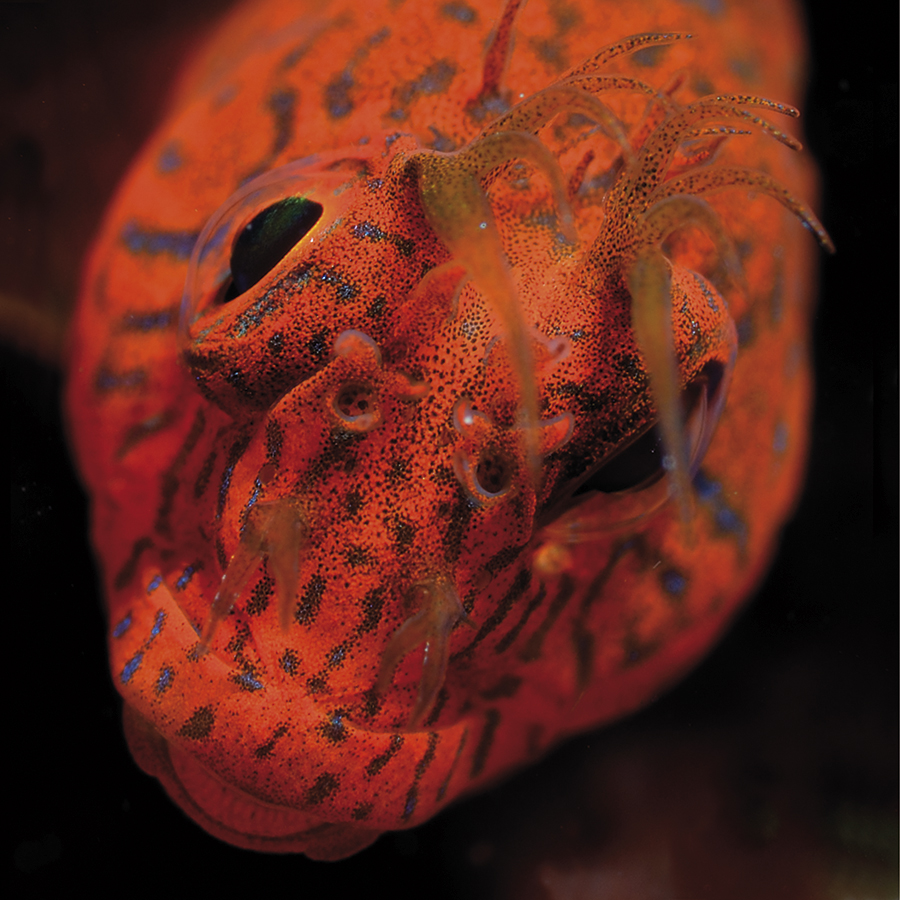 The difficult classification of the various species is significantly represented by this picture, that depicts a specimen of a horned blenny (Parablennius zvonimiri), easily confusingly with the “african” one we’ve just met.
The difficult classification of the various species is significantly represented by this picture, that depicts a specimen of a horned blenny (Parablennius zvonimiri), easily confusingly with the “african” one we’ve just met.
When I took the shot there was a rather strong undertowthat made difficulties in framing and putting in fire a very small subject, which swayed coming in and out from the den. Its color and livery recall tropical subjects. When the appendages on the head bent in the current I had an hint, and even more than an hint of seasickness.
(Ventotene - Latina)
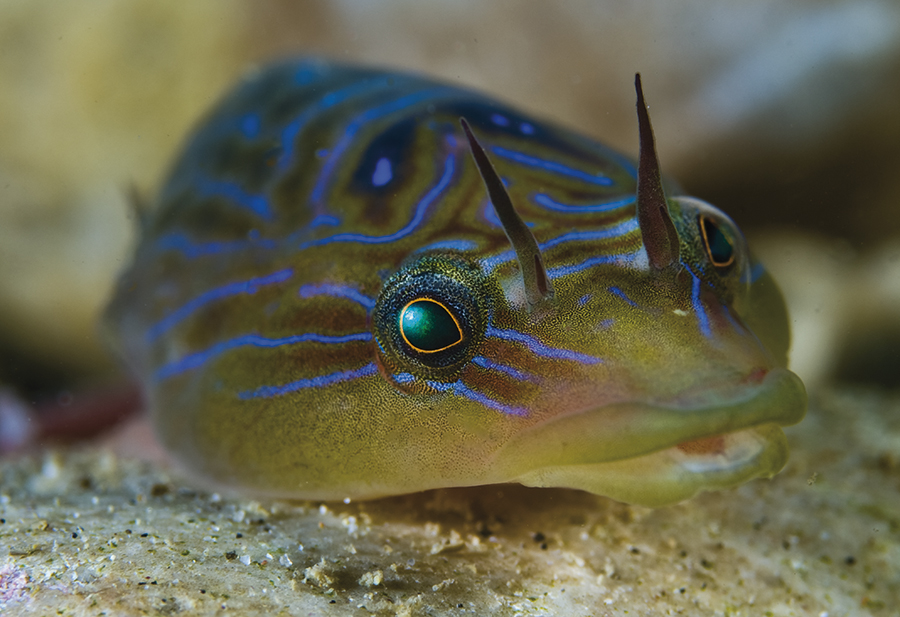 How many times it happens to divers to perform decompression stops along a pebbly seabed? Well, it could be a good idea if they took the trouble to turn the stones over. If they did (repositioning stones how they were, because there is an incredible cosmos based on very delicate balances of light under the rocks), they often would notice a flash of color moving away. It is the “suckerstone”, a rather common and amazing fish, and worthy of many tropical ones: it could be the Mediterranean sea “mandarin” fish, which lives in the Pacific ocean, it shares some traits with.
How many times it happens to divers to perform decompression stops along a pebbly seabed? Well, it could be a good idea if they took the trouble to turn the stones over. If they did (repositioning stones how they were, because there is an incredible cosmos based on very delicate balances of light under the rocks), they often would notice a flash of color moving away. It is the “suckerstone”, a rather common and amazing fish, and worthy of many tropical ones: it could be the Mediterranean sea “mandarin” fish, which lives in the Pacific ocean, it shares some traits with.
It lives in dark environments, it comes out from after sunset but it has a very powerful suction cup, if compared to its size. The look of the suckerstone really makes you think of Walt Disney’s Donald Duck. The one portrayed here, the horned suckerstone (Lepadogaster lepadogaster) was incredible: showy “discovered” - in every sense - it pointed me such as a white shark without eating anything for ten days, and then suddenly disappeared from my eyes with a flash. I searched it for a couple of minutes turning all the stones, but without any result. I was really dejected, because I had guessed its beautiful color. I moved towards the shore, when I noticed an imperceptible movement under the elbow while I deflated the jacket ... he had sheltered in the shadow of my arm, exchanging the black of the dry suit, in the shade, as a reassuring temporary, however moving shelter! It was made not without difficulty - the suction cup is powerful - but just laid on a stone it granted two shots to me, one of which while he was fleeing like a crazy guy.
(Praiano - Salerno)
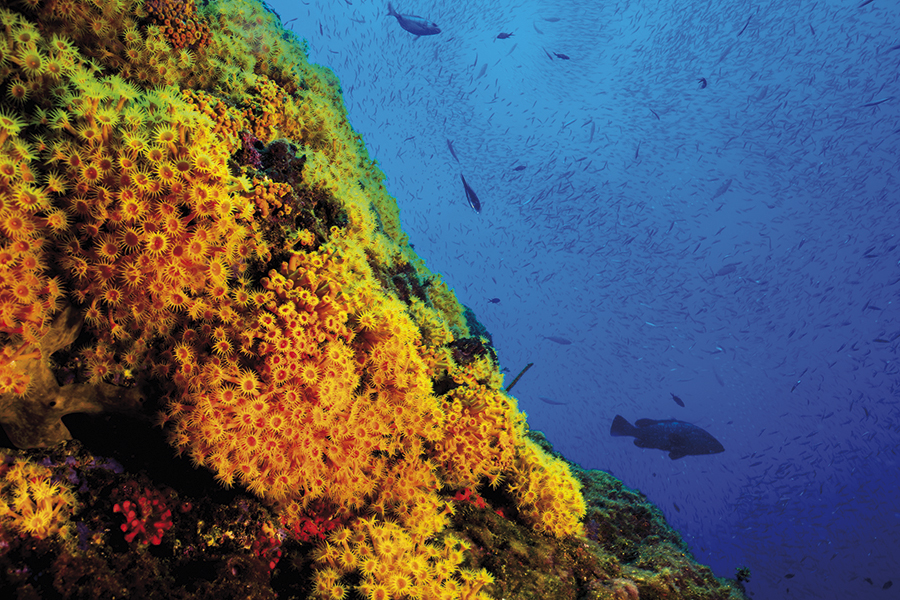 A scene shows abundance of life of Mediterranean sea, too quickly condemned to disappear: a colony of so called “sea daisies” (Parazoanthus axinellae). In the background you can see a grouper hunting among anchovies school. Sea daisies belong to Tubastraea coral
A scene shows abundance of life of Mediterranean sea, too quickly condemned to disappear: a colony of so called “sea daisies” (Parazoanthus axinellae). In the background you can see a grouper hunting among anchovies school. Sea daisies belong to Tubastraea coral
genus. Of color in the shaded areas, growing also in low depth.
(Castellammare di Stabia - Naples)
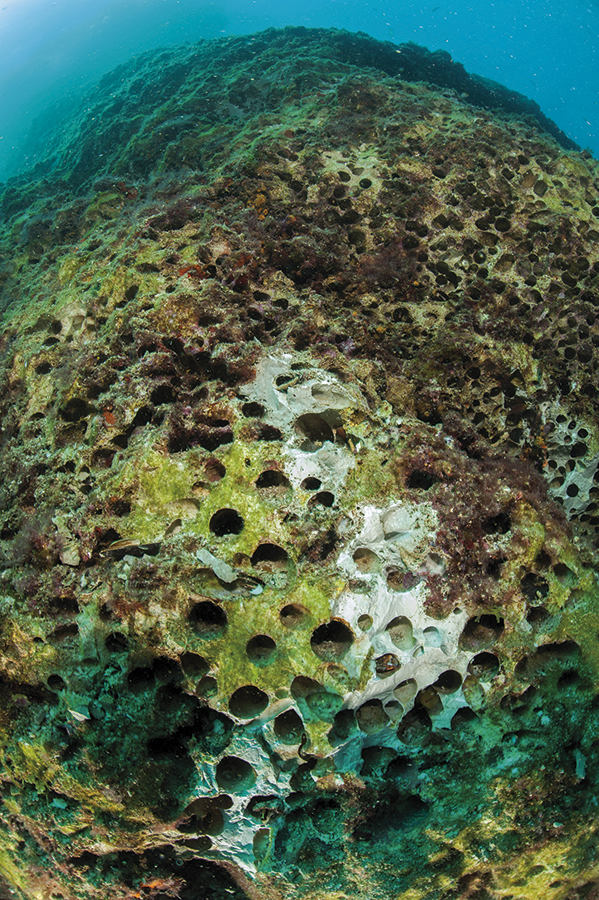
Tubastrea corals are often destroyed by criminals. Really along Amalfi and Sorrento coasts a great problem is represented by the so called sea dates fishermen. Sea dates’s scientific name (Li.....) clearly explains its feature, since in greek language it means “rock eater” are clams living inside the rock. They pierce them with a mucus they produce and lead their vital cicle there. In the meantime rocks are covered with all animals and algae, tubastrea in particular.
The unlucky circumstance is that sea dates are delicious, and some criminals don’t hesitate to destroy walls of stone to hunt sea dates and sell them in illegal markets. They use hammers and kill all kind of life grown up the rocks, that will take many years to revive.
It’s an environmental damage on a massive scale.
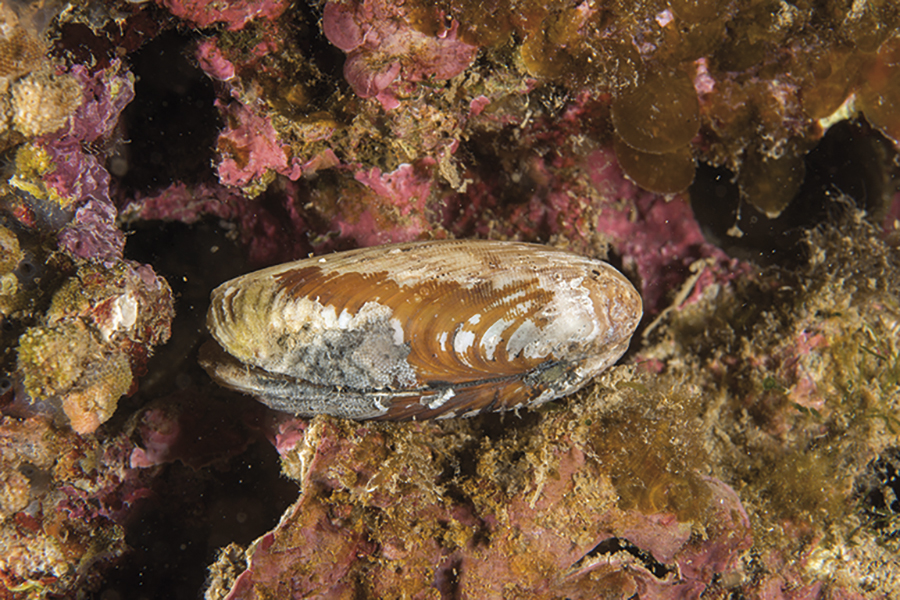 Sometimes it happens that a sea date escapes the human hunters. Its survival is still unlikely, being the victim of some fish or gastropod that sucks fruit.
Sometimes it happens that a sea date escapes the human hunters. Its survival is still unlikely, being the victim of some fish or gastropod that sucks fruit.
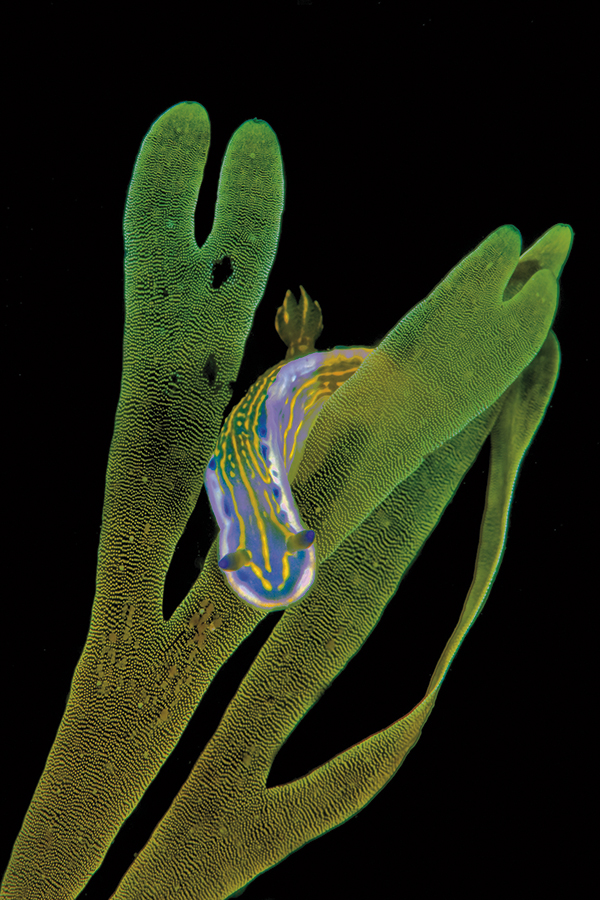
A tiny juvenile specimen of Felimare picta walking on a ribbon alga (Dictyota
dichotoma) is a picture of great elegance.
Many species of nudibranchs, often those with the most spectacular liveries, even in adulthood are long less than half an inch. This is not the case of the species portrayed in the shot, which is among the largest specimens of the genus and often exceeds eight inches, but it remains similar to the color of its juvenile phase. Its characteristic is the variability of the background colors, from yellow to blue/purple, so that for a certain period scientists thought that the blue with yellow rings sample was a different species, identified with the Hypselodoris webby.
(Pozzuoli - Naples)
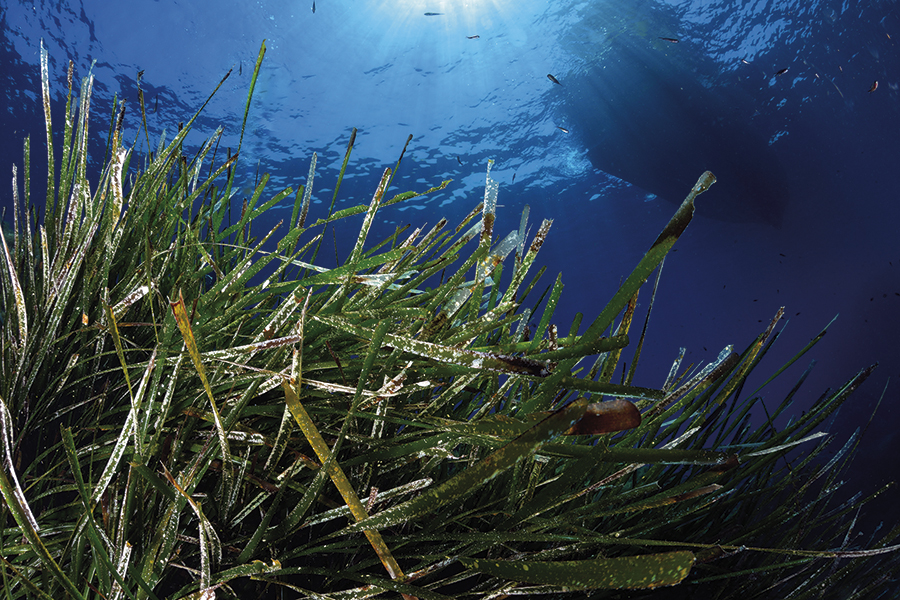 Posidonia oceanica plants are back.
Posidonia oceanica plants are back.
The extraordinary value of posidonia doesn’t stop with qualities already described at the beginning of the dive a natural barrier against beach erosion and that provides
oxygen to the marine environment. The prairies are environments where various species of molluscs, crustaceans and coelenterates are housed, and are also used as a food resource by various fishes that, as we will see in a little, move nearby. Incredibly, even once dried, the leaves of the plant continue to supply vital energy, in fact they are used in various countries as fuel or as fertilizer in agriculture, thus concluding a virtuous environmental circle.
(Ustica - Palermo)
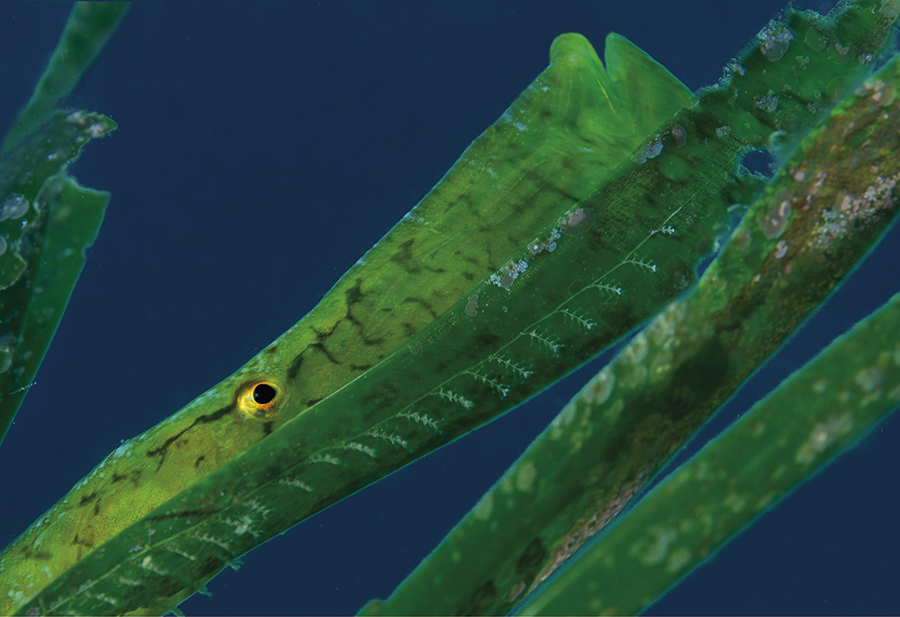 ... and among posidonia leaves, as a last gift, we are able to take note of the incredible camouflage skill of the horse-headed fish (Syngnathus typhle). It is very similar to the Caribbean tropical counterparts, which in turn make their ability a defensive and offensive tool. Here it seems to play hide and seek in the middle of the leaves. This time he lost the game.
... and among posidonia leaves, as a last gift, we are able to take note of the incredible camouflage skill of the horse-headed fish (Syngnathus typhle). It is very similar to the Caribbean tropical counterparts, which in turn make their ability a defensive and offensive tool. Here it seems to play hide and seek in the middle of the leaves. This time he lost the game.
(Praiano - Salerno)
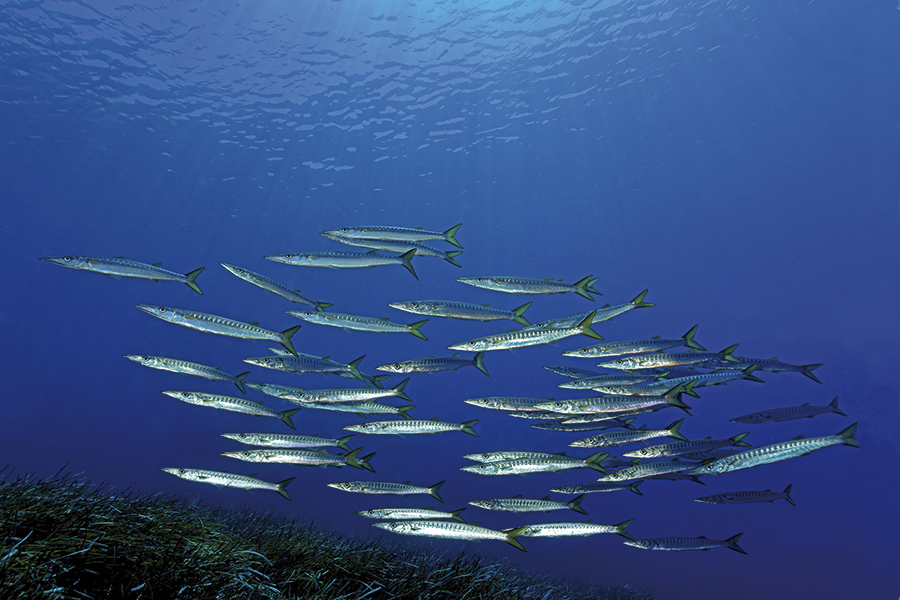 The Posidonia prairie, besides being the microcosm of various gastropods and coelenterates, is also the natural “nursery” for many species of fish such as young Mediterranean barracudas.
The Posidonia prairie, besides being the microcosm of various gastropods and coelenterates, is also the natural “nursery” for many species of fish such as young Mediterranean barracudas.
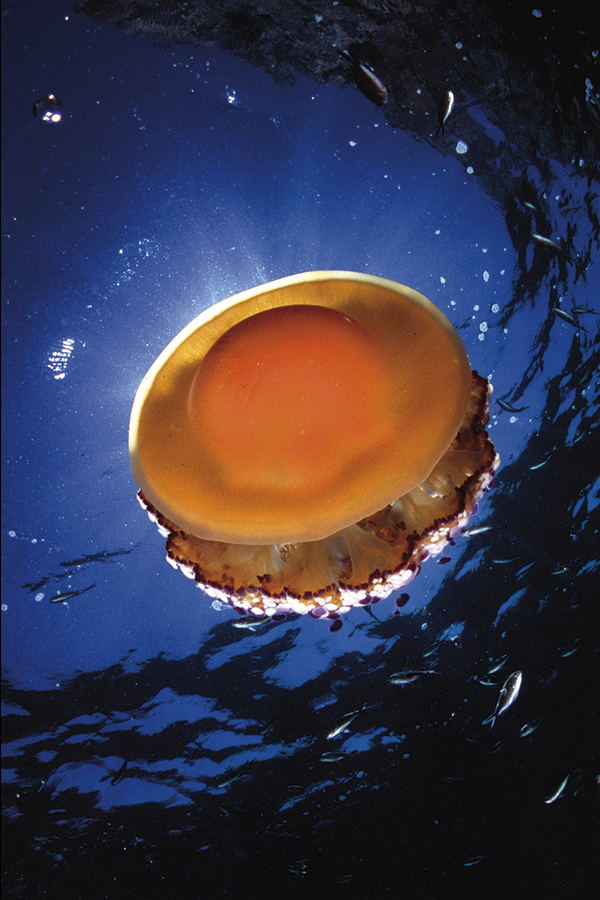
Meanwhile the fantastic Cassiopea (Cotylorhiza tuberculata) seems to continue to warm up in the Mediterranean sun. And if the lack of stinging cells, as seen at the beginning of the dive, is typical of jellyfishes living in waters without natural enemies, it is even more surprising to know that these animals, composed almost exclusively of water, not only aspire, like man, to immortality, but ... they did it. Scientific curiosity is in fact that just a tiny jellyfish, the
Turritopsis dohrnii manages to egenerate its cells indefinitely, in practice it regenerates itself, it is an Arabian marine phoenix. When myth becomes reality...
(Palau - Olbia)
(Ustica - Palermo)
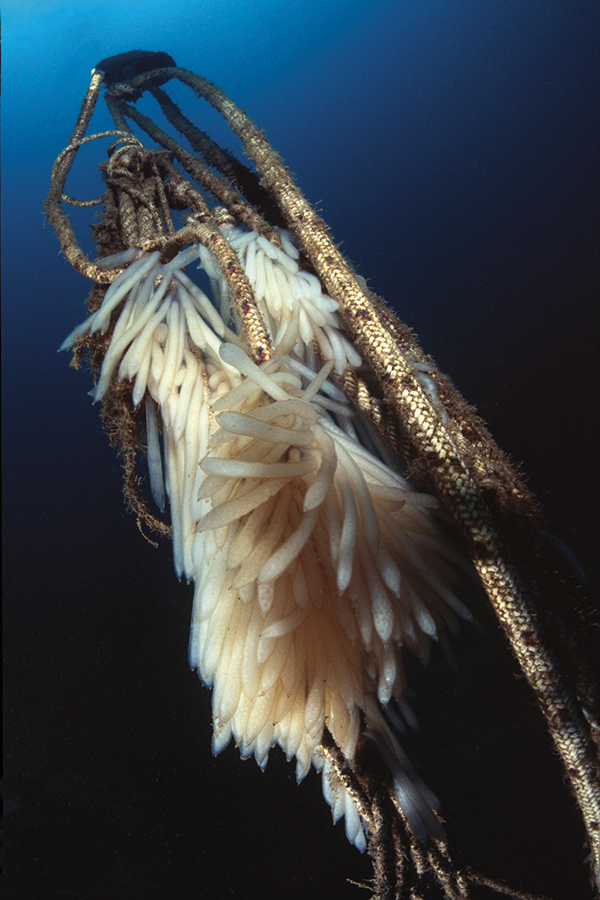
Looking upwards, a scene seems to me the symbol of the necessary union between earth and creatures of the sea: a squid has chosen an abandoned peak of a dead nautical buoy to lay down their own eggs: the future of marine life is someway linked to an human object.
(Praiano - Salerno)
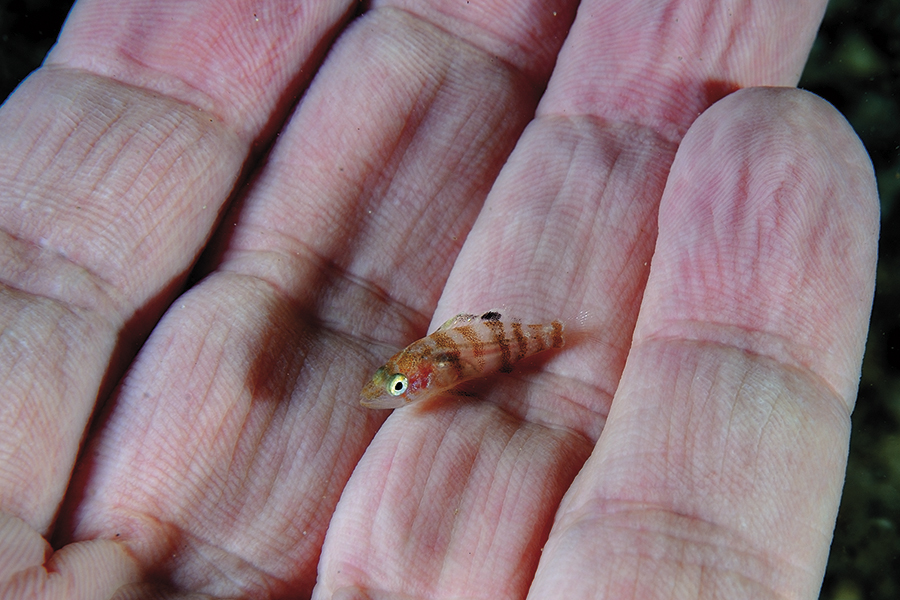 A tiny specimen of “sciarrano” (Serranus hepatus) literally relies on the hands of the photographer. It seems seeking shelter and protection. “Nature” asks for responsibility. Life of every little or big creature is influential on the mainland as well as at sea, in Mediterranean sea as in the oceans. (Praiano - Salerno)
A tiny specimen of “sciarrano” (Serranus hepatus) literally relies on the hands of the photographer. It seems seeking shelter and protection. “Nature” asks for responsibility. Life of every little or big creature is influential on the mainland as well as at sea, in Mediterranean sea as in the oceans. (Praiano - Salerno)
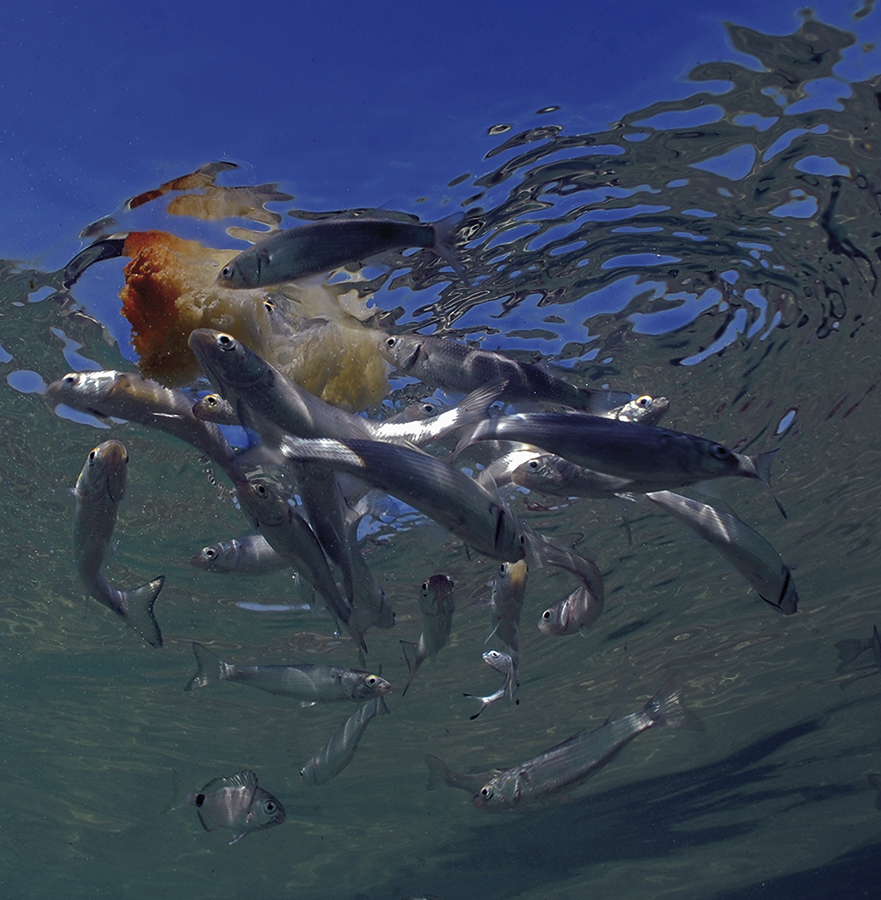 Small mullets (Mugil cephalus) below the surface don’t hesitate to eat bread.
Small mullets (Mugil cephalus) below the surface don’t hesitate to eat bread.
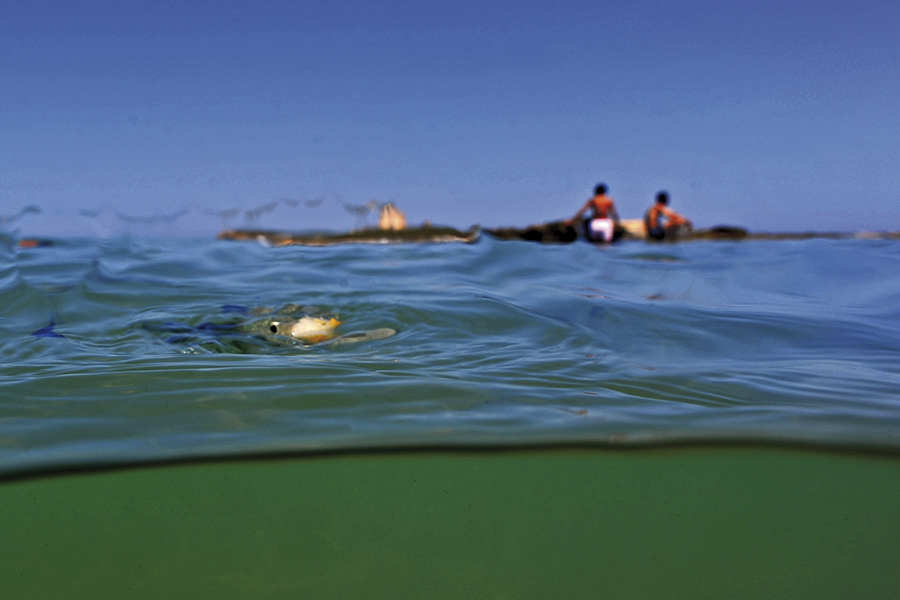 Shortly thereafter, for a fraction of a second, an eye of one of them comes out of the water while two children play “unaware” among waves. If instead of the innocent little fish there had been a shark, the shot would have been evocative of the famous movie by Spielberg. Let’s humorously call it “Mediterranean terror”. (Porto Palo - Syracuse)
Shortly thereafter, for a fraction of a second, an eye of one of them comes out of the water while two children play “unaware” among waves. If instead of the innocent little fish there had been a shark, the shot would have been evocative of the famous movie by Spielberg. Let’s humorously call it “Mediterranean terror”. (Porto Palo - Syracuse)
 We are at the extreme edge of Italy, or the first strip of Africa.
We are at the extreme edge of Italy, or the first strip of Africa.
Landscape well represents geographic latitude, showing a “real” tropic of the Mediterranean.
(Porto Palo - Syracuse)
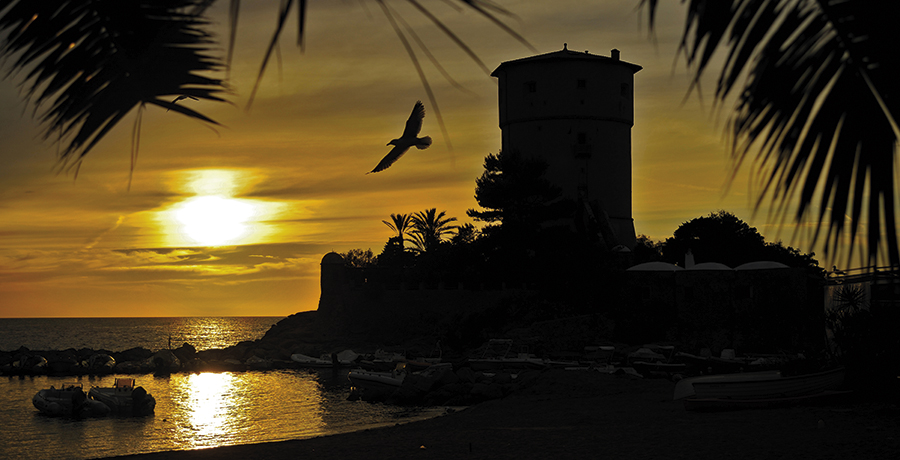 The palms of Campese village, on the south side of the island, the “Medici” family tower and a seagull in the colors of the sunset seem to evoke southern seas atmospheres.
The palms of Campese village, on the south side of the island, the “Medici” family tower and a seagull in the colors of the sunset seem to evoke southern seas atmospheres.
(Giglio island - Grosseto)


